A.P.J. Abdul Kalam
A.P.J. Abdul Kalam was an Indian scientist and politician who served his country as president from 2002 to 2007.

(1931–2015)

Quick Facts
Early years, rise to the presidency, death and legacy, who was a.p.j. abdul kalam.
A.P.J. Abdul Kalam was an aerospace scientist who joined India's defense department after graduating from the Madras Institute of Technology. He was a central figure in the development of the country's nuclear capabilities and was hailed as a national hero after a series of successful tests in 1998. Kalam served as India's president for one term from 2002 to 2007, and died of a heart attack on July 27, 2015.
FULL NAME: A.P.J. Abdul Kalam BORN: October 15, 1931 DIED: July 27, 2015 BIRTHPLACE: Dhanushkodi, Rameswaram, India SCHOOLS: Madras Institute of Technology, St. Joseph's College ASTROLOGICAL SIGN: Leo
Avul Pakir Jainulabdeen Abdul Kalam was born into a Muslim family on October 15, 1931, on the island of Dhanushkodi off the southeastern coast of India. He developed an early fascination with flight by watching birds, which developed into an interest in aeronautics after he saw a newspaper article about a British fighter plane.
Despite his modest beginnings – his dad built and rented boats – Kalam was a bright student who showed promise in science and mathematics. He attended St. Joseph's College and went on to earn a degree in aeronautical engineering from the Madras Institute of Technology.
His hopes of becoming a fighter pilot were dashed when he narrowly missed out on a spot with the Indian Air Force. Kalam instead joined the Defense Research and Development Organization (DRDO) as a senior scientific assistant in 1958. After moving to the newly formed Indian Space Research Organization (ISRO) in 1969, he was named project director of the SLV-III, the first satellite launch vehicle designed and produced on Indian soil.
Returning to the DRDO as director in 1982, Kalam implemented the Integrated Guided Missile Development Program. He then became the senior scientific adviser to India's defense minister in 1992, a position he used to campaign for the development of nuclear tests.
Kalam was a key figure in the May 1998 Pokhran-II tests, in which five nuclear devices were detonated in the Rajasthan Desert. Although the tests resulted in condemnation and economic sanctions from other world powers, Kalam was hailed as a national hero for his staunch defense of the country’s security.
In 2002, India's ruling National Democratic Alliance helped Kalam win an election against Lakshmi Sahgal and become India's 11th president, a largely ceremonial post. Known as the People's President, Kalam set a goal of conducting 500,000 one-on-one meetings with young people over the course of his five-year term. His immense popularity led to him being nominated by MTV for a Youth Icon of the Year award in 2003 and 2006.
After leaving office in 2007, Kalam became a visiting professor at several universities. He formed the "What Can I Give Movement" in 2011 with the goal of creating a compassionate society, and in 2012, his efforts to improve healthcare led to the release of a tablet for medical personnel to use in remote areas.
On July 27, 2015, Kalam suffered a massive heart attack while lecturing at the Indian Institute of Management and subsequently died at the age of 83.
Kalam was laid to rest on July 30 with full state honors in his native Tamil Nadu. In honor of the scientist and former president, the southeast Indian state government of Tamil Nadu created a "Dr. A.P.J. Abdul Kalam Award," which recognizes exceptional individuals who promote the sciences, students and humanities. The government has also established Kalam's birthday (October 15) as "Youth Renaissance Day." Discussion about building a large-scale memorial at his burial site is underway.
Among his many accolades, including honorary doctorates from 40 universities, he was granted the Padma Bhushan (1981), the Padma Vibhushan (1990) and the Bharat Ratna (1997) — India's highest civilian awards — for his contributions in modernizing government defense technology. He also wrote several books, including the autobiography Wings of Fire in 1999.
Fact Check: We strive for accuracy and fairness. If you see something that doesn't look right, contact us !
The Biography.com staff is a team of people-obsessed and news-hungry editors with decades of collective experience. We have worked as daily newspaper reporters, major national magazine editors, and as editors-in-chief of regional media publications. Among our ranks are book authors and award-winning journalists. Our staff also works with freelance writers, researchers, and other contributors to produce the smart, compelling profiles and articles you see on our site. To meet the team, visit our About Us page: https://www.biography.com/about/a43602329/about-us
Famous Political Figures

10 of the First Black Women in Congress

Kamala Harris

Deb Haaland
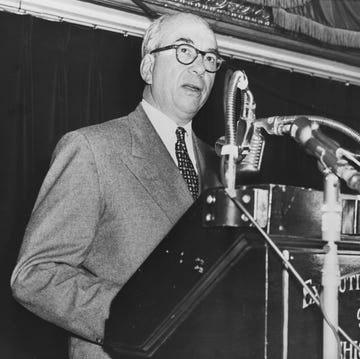
Why Lewis Strauss Didn’t Like Oppenheimer

Madeleine Albright

These Are the Major 2024 Presidential Candidates

Hillary Clinton

Indira Gandhi

Toussaint L'Ouverture

Vladimir Putin

Kevin McCarthy
Talk to our experts
1800-120-456-456
- Dr. A P J Abdul Kalam Biography

The Missile Man of India: Dr. APJ Abdul Kalam
Great personalities are not born every day; they are born once in a century and are remembered for millennials to come. One such great personality that we will always be proud of is Dr. APJ Abdul Kalam . His full name was Avul Pakir Jainulabdeen Abdul Kalam, born in Rameswaram of Madras Presidency on 15th October 1931 and died on July 27, 2015, Shillong. He was an Indian Scientist and also a politician leader, who later became the 11th President of India. He played an important role in the development of India’s missile and nuclear weapons program.
It is an absolute honor for us to learn about his great leader in the form of his biography . Without much ado, let us start.
Dr. A P J Abdul Kalam's Biography - About His Family and Struggle Life
Dr. A P J Abdul Kalam was born to a poor Tamil Muslim family. He lived with his family in the temple city of Tamilnadu, Rameswaram, where his father, Jainulabdeen, had a boat and was an imam of a local mosque. At the same time, his mother, Ashiamma, was a housewife. Kalam had four brothers and one sister in his family, from which he was the youngest. Kalam's ancestors were wealthy traders and landowners and had vast land and property tracts. But with time, their business of ferrying pilgrims and trading groceries suffered huge losses due to the Pamban Bridge's opening. As a result, Kalam's family had become inadequate and struggled hard to make a living. At a tender age, Kalam had to sell newspapers to supplement his family income.
Dr. A P J Abdul Kalam's Biography - Educational Background of Kalam
Although Kalam had average grades in school, he was very hard working and had an immense desire to learn. He spent a lot of time studying and had developed a particular interest in mathematics. Kalam left Schwartz higher secondary school after completing his early education and went to Saint Joseph's College, Tiruchirapalli . From Saint Joseph's College, he graduated in physics in 1954. He moved to Madras in 1955 to study aerospace engineering at Madras Institute of Technology.
Dr. A P J Abdul Kalam's Biography - Kalam as a Scientist
Kalam joined as a scientist in the aeronautical development establishment of DRDO in 1960, after graduation. His career started with him designing a small hovercraft. However, he was not convinced by his choice of a job at the DRDO. Kalam was transferred to ISRO in 1969, where he was the project director of India's first satellite vehicle launch. The satellite vehicle deployed the Rohini satellite successfully in near-Earth orbit in July 1980. Kalam received the Government's LV and Slv projects between the 1970s-90s. He directed two projects like Project Devil and Project Valiant, which aimed at developing ballistic missiles from the successful SLV program's technology Kalam somehow convinced Indira Gandhi and sought secret funds for these aerospace projects. His research and immense knowledge brought him and the nation great laurels in the 1980s.
Kalam then went on to become the scientific advisor of the defence minister in 1992 and served at the same post for five years before getting promoted to the post of principal scientific advisor to the government. His immense role in the country's 1998 nuclear weapons tests solidified India as a nuclear power. Kamal had now become a national hero, to be remembered for ages to come. However, the tests he conducted caused a huge uproar in the international community. Kamal put forward a nationwide plan called Technology Vision 2020 , which according to him, was a fantastic way for transforming the stature of India in 20 years, taking it from a developing to a developed nation. The plan envisioned the progress of the nation by adopting advanced technology, expanding healthcare facilities, and emphasizing the education of the masses.
Dr. A P J Abdul Kalam's Biography -Kalam as the 11th President of India
Sir Kalam was entitled to be the 11th president of India. His term period of 25th July 2002 to 25th July 2007 was achieved by winning a presidential election in 2002 with a massive margin of votes. National Democratic Alliances’ nominated him to be president and it was supported by Samajwadi Party and National Congress Party. He was lovingly called as peoples’ president as he had done uncountable works for the welfare of the people and through the entire country.
He was brave and courageous enough to take decisions and implement them no matter if that was tough or sensitive or highly controversial. The “office of profit” is perhaps the hard Act that he had to sign. The “ office of profit ”, according to the English Act of Settlement in 1701 explains that no single individual who has a professional set up under the royal family, who has some kind of provision with or who is taking a pension from the prince has the right to work for the of the “ House of Commons ”. This will allow the royal family to have zero influence on the administrative conditions.
He had also become one of the most talked-about presidents Rule in 2005 for imposing the Presidents’ rule in Bihar. Kalam expressed his wish to take up the position one more time but then later changed his mind.
After taking farewell from the office, he shifted and commenced his career as a visiting professor at the Indian Institute of Management in Shillong. He served as an Aerospace Engineering professor at Anna University, Tamil Nadu. He also lit up educational institutions like the Indian Institute of Indore, Indian Institute of Bangalore with his presence and knowledge. Sir Kalam served as chancellor Indian Institute of Space Science and Technology, Thiruvananthapuram.
In 2012, he introduced a program called “ What Can I Give ?” focusing on the theme of eradicating corruption from the country.
Dr. A P J Abdul Kalam's Biography - The Demise of Abdul Kalam
Abdul Kalam was a mortal human being just like us, but for his contribution to the country he remained immortal in the hearts of people. Dr. APJ Abdul Kalam was one such personality who died at 83. It was shocking news for the entire country as a pure soul left us forever. Abdul Kalam while delivering a speech for the youth in an event at IIM Shillong. During the middle of the speech, he suffered from a cardiac arrest and collapsed. Although he got admitted to the best hospital in Shillong, the doctors could not save him.
Then his body was airlifted to Gugati, and from there, it was taken to New Delhi in an Airforce plane. Their President, vice president, and some other leaders prayed for his soul. His body was then covered in the Indian National flag and brought to his hometown. About 35000 people attended his funeral event and prayed for such a great soul.
Dr. A P J Abdul Kalam's Biography - Writings of Dr. APJ Abdul Kalam
Dr. Abdul Kalam was a person who was not only a great political leader but also a good teacher and a writer. He had many delicate qualities and visionaries. He always had an excellent dream for the country's development and realized that the youth can bring revolution. During his university career, he inspired many of the students through his inspirational speech and tremendous visionaries. Apart from this, Dr. Kalam was a great writer. He has written several books, which are mainly meant for the nation's empowerment. His creation of India 2020 was like a gift for us, and he had all the strategies to make India a Superpower. In this book, he had primarily focused on some factors like food and development in the Agriculture sector, improved health care facilities, advanced information and communication system, good infrastructure, sufficiency in electricity production, Self-reliance in some advanced technologies.
Dr. A P J Abdul Kalam's Biography - Achievements of Abdul Kalam
Abdul Kalam was a person of a golden heart who has received ample awards and achieved many things during his life journey. In 1981 Abdul Kalam received the prestigious Padma Bhushan award. In 1990 he received the Padma Bhushan award. The renowned personality, because of his tremendous effort towards the nation, received the Bharat Ratna in 1997. In the same year, he was awarded the Indira Gandhi Award for National Integration. The government of India awarded Kalam with the Veer Savarkar award in 1998. Because of his contribution to arts, science, and technology, he received the SASTRA Ramanujan prize in 2000. Finally, in the year 2013, the eminent personality was bestowed with the Von Braun Award by the National Space Society.
Abdul Kalam’s Profession
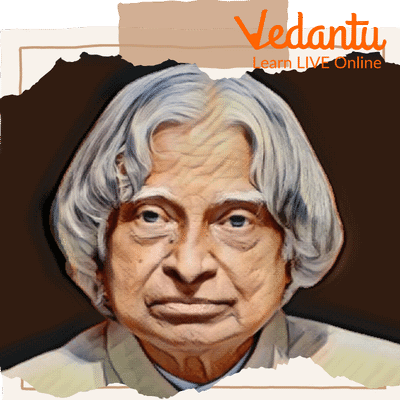
APJ Abdul Kalam
This complex persona was a notable researcher displaying huge and unending science and mechanical innovative work. It was he who made our country atomic in its most genuine sense. It was in the year 1974, under the oversight of Dr. Kalam, that India went through its most memorable atomic test. Next came the Pokhran - II in the year 1988. It was through these atomic tests Dr. Kalam showed the world India's situation and power in atomic innovation.
Abdul kalam’s Grants and Accomplishments
His works granted him three great honours from the Govt. of India specifically Padma Bhushan, Padma Vibhushan, and the Bharat Ratna. In the year 1997, Kalam was likewise granted the Indira Gandhi Award for National Integration. He was granted the Veer Savarkar Award in the year 1980 and the Ramanujan Award in the year 2000. From 40 colleges all over the world, Kalam got privileged doctorates.
Kalam’s Works and Motivation
He was the writer of various motivational books like "India 2010", "Touched off Minds", "Mission India", "The Luminous Sparks", "Wings of Fire", and "Moving Thoughts".
His life, work, and convictions are loaded up with models and motivations. He will keep on inspiring us for eternity. Furthermore, this is the genuine justification for why individuals from every one of the segments of the general public precipitously show love for this incredible person on his miserable end at IIM Shillong on 27th July 2015.
May this Noble and faithful Soul find happiness in the hereafter!
Dr. A P J Abdul Kalam's Biography - Some Interesting Facts
Let us now study some interesting facts about Dr. A P J Abdul Kalam:
His full name was Avul Pakir Jainulabdeen Abdul Kalam.
He was born in a Tamil Muslim Family.
Kalam was a vegeterian. In his words “I was forced to become a vegetarian due to financial constraints, but I eventually came to enjoy it.” Today, I am a complete vegetarian”
He was India’s ‘first bachelor President.
He was very popular among children.
Kalam’s autobiography ‘Wings of Fire was initially published in English Language but then later published in 13 other languages.
Although the life of Abdul Kalam was filled with struggles and hardships, he rose above the adversaries to become one of the greatest scientists of modern India. His role in nation-building will be remembered till posterity.
Abdul Kalam was elected as the eleventh president of India in 2002 with the assistance of the ruling Bharatiya Janata Party and the then-competition Indian National Congress. He is widely referred to as the "People's President". He spent four decades as a scientist and science administrator, especially on the Defence Research and Development Organisation (DRDO) and Indian Space Research Organisation (ISRO), and became concerned with India's civilian space program and army missile improvement efforts.
Abdul Kalam lowered back to his civilian lifestyle of schooling, writing, and public career after a single term. He received Bharat Ratna for his prestigious work.

FAQs on Dr. A P J Abdul Kalam Biography
1. Why is Abdul kalam known as the Missile man of India?
Being the largest democratic country globally, India did not have the right image in front of the world. As our country did not have any ballistic missiles or nuclear missiles, it was like a weaker country.
Abdul Kalam had a different thought in his mind, and he was the only person who tried to bring revolution to the country through modern and advanced defence power. As a scientist, he encouraged other scientists of ISRO and DRDO and developed some powerful ballistic missiles with indigenous technology. E also talked with the prime minister of India, Indira Gandhi, and arranged some secret funds, which was very much useful for running such crucial projects. However, Kalam was first tied to empower India and created a strong image in front of the world. So Kalam is famous as the Missile man of India.
2. How Abdul Kalam became the President of India?
As a professor, Kalam used to spend some happy moments with students and other professors at Anna University. He loved teaching students something interesting with tremendous enthusiasm. Although the classroom's strength was sixty every day, around 350 youths gathered in his classroom to listen to a great professor's inspiring lecture. There was nothing unusual with that; he only used to understand a dynamic youth's mind and expressed his emotions through lectures. He used to emphasize his vision of modernizing the country and social transformation. He was assigned to teach ten lessons to the postgraduate students, and in the ninth lecture, he gave the example of several case studies. This was the most crucial period of his political career. The university's VC informed that he was receiving many calls, and many of the people wanted to talk.
Then he received a call from the Prime minister of India, and he was shocked to listen to the news that many of the party leaders and the nation want him as the President of India. He did not control his emotion during that time as many pictures came to his mind like he was teaching inside the classroom and addressing inside the Parliament. This news became viral Abdul Kalam as a presidential candidate. Finally, Abdul Kalam won the presidential election and became the PresidentPresident of India's largest democratic country.
3. Why Abdul Kalam is renowned as the Youth Icon?
Dr. Abdul Kalam was the person who brought a revolution in the country in the field of Science, technology, aerospace, and Missile technology. He was the person who witnessed the nuclear test of India twice. He played a crucial role in the advancement of DRDO and ISRO. He was also on the advisory committee of the Defence minister. Coming from a low-income family, he had shown his mission and visionaries for the country's modernization. He also became the PresidentPresident of the country once and presented his thoughts and developed many indigenous ballistic missiles. Besides this, he was like an inspiration among youth and changed many students' motto as a professor. People are mad to listen to his inspirational words. All these god gifted qualities made him a youth icon.
4. What is the “Wings of Fire” all about?
Wings of Fire is an autobiography written by our beloved late President Dr. A.P.J Abdul Kalam. The book narrates the story of Sir Kalam through an extremely inspirational path. It clearly showcases the struggles he had to go through, the discrimination he had to face, the resilience and persistence he kept alive, the achievements he had made, and the dreams that had in him which let him fly high. The book is divided into 3 sections. The first section talks about his childhood and youth life. He was born to a financially humble family, but the members including his parents had good vision and heart. With much struggle, he completed his studies and first joined as a trainer in Hindustan Aeronautics Limited. Sir also mentions the people who helped the young Kalam to transform himself into a person who influences millions of people.
The second section, called creation, explains his seventeen years of work-life and propitiation, which is the third section, travels the journey of a scientist to the “missile man of India”.
5. What were the 5 ways in which Dr. Kalam wanted to change India?
The five ways in which Dr. Kalam wanted to change India are the following:
What I Can Give Movement: This Movement was launched by A.P.J Abdul Kalam in order to spread awareness and understanding among the Indian youth about the danger of corruption and defeat it. The central theme is also the same. This notion was introduced to youngsters with an aim of creating change in their mindset from “greed” to what can be given from their side for societies’ benefit.
Billion Beats: Billion Beats is an e-paper that was founded by Dr. Kalam in 2007. It got circulated for a while and later got converted into a Facebook page. This digital platform page was used by him as a medium to share his interactions with achievers and their triumphs.
India Vision 2020: Composed by the Technology Information Forecasting and Assessment Council, this plan was primarily a document, when Kalam sir was the chairman. But later, this significant transition project is elaborately explained in his book, wherein he identifies agriculture, infrastructure, education and healthcare, information and communication technologies and so on to be some of the core areas that should be concentrated to improve the GDP rate.
Pura: Aiming to build economic opportunities outside the cities and promote different migration from urban to rural, the Provision of Urban Amenities to Rural Areas was developed.
Igniting Minds: This program acts as a bridge that connects about I lakh students to scientists, technicians and other leaders to make the learning of science much more exciting. The project is named after his successful book.
6. Where did Abdul Kalam live as a child?
Abdul Kalam was born in a centre-magnificence Tamil circle of relatives in the island town of Rameswaram inside the country of Madras. His father, Jainulabdeen possessed notable innate wisdom. His mother, Ashiama turned into an ideal helpmate of his father. They lived in their ancestral pucca residence, located on mosque street in Rameswaram.
7. What do APJ Abdul Kalam do?
Dr. APJ Abdul Kalam became the previous President of India and was referred to as Indian scientists. He was additionally related to India's Space and Missile Development Program, hence called Missile Man of India. Take this quiz on Dr. A.P.J. Abdul Kalam to recognize more approximately him. Dr. APJ Abdul Kalam's complete name is Avul PakirJainulabdeen Abdul Kalam.
Avul Pakir Jainulabdeen Abdul Kalam become born on 15 October 1931, to a Tamil Muslim own family in the pilgrimage centre of Rameswaram on Pamban Island, then in the Madras Presidency and now in the State of Tamil Nadu.
8. Why is APJ Abdul Kalam referred to as the Missile Man of India?
A.P.J. Abdul Kalam became an outstanding Indian scientist who served as the eleventh President of India from 2002 to 2007. Renowned for his pivotal role within the state’s civilian area program and army missile development, he was referred to as the Missile Man of India.
- Bihar Board
SRM University
Ap inter results.
- AP Board Results 2024
- UP Board Result 2024
- CBSE Board Result 2024
- MP Board Result 2024
- Rajasthan Board Result 2024
- Shiv Khera Special
- Education News
- Web Stories
- Current Affairs
- नए भारत का नया उत्तर प्रदेश
- School & Boards
- College Admission
- Govt Jobs Alert & Prep
- GK & Aptitude
- general knowledge
APJ Abdul Kalam Biography: Inventions, Achievements, Death Date, Quotes, Full Name, Education & other details
Apj abdul kalam death anniversary is being observed on july 27. know more about apj abdul kalam's inventions, death date, achievements, education, early life, family and other details. .

APJ Abdul Kalam Biography: Dr. APJ Abdul Kalam was an Indian aerospace scientist who served as the 11th President of India from 2002 to 2007. He was born on October 15, 1931, raised in Rameswaram, Tamil Nadu, and studied Physics and aerospace engineering. APJ Abdul Kalam was elected as the 11th President of India in 2002 with the support of both the ruling Bharatiya Janata Party and the then opposition Indian National Congress party. Also referred to as ‘People’s President’, APJ Abdul Kalam returned to his civilian life of education, writing, and public service after serving only one term.
APJ Abdul Kalam Biography
Apj abdul kalam early life, education.
Dr. APJ Abdul Kalam was born on October 15, 1981, to a Tamil Muslim family in the pilgrimage center of Rameswaram on Pamban Island. It was then in the Madras Presidency under British India and is now in the State of Tamil Nadu.
APJ Abdul Kalam’s father Jainulabdeen Marakayar was a boat owner and imam of a local mosque while his mother Ashiamma was a housewife. His father also owned a ferry that took Hindu pilgrims back and forth between Rameswaram and the now uninhabited Dhanushkodi.
APJ Abdul Kalam was the youngest of four brothers and one sister in his family. His family had been wealthy Marakayar traders and landowners, with numerous properties and large tracts of land. With the opening of the Pamban Bridge to the mainland in 1914, however, the businesses failed and the family fortune and properties were lost over time, apart from the ancestral home.
APJ Abdul Kalam Education
Apj abdul kalam as a scientist.
After graduating from the Madras Institute of Technology in 1960, APJ Abdul Kalam joined the Aeronautical Development Establishment of the Defence Research and Development Organisation (DRDO) as a scientist after becoming a member of the Defence Research and Development Service. He started his career by designing a small hovercraft, however, remained unconvinced by his job at DRDO.
In 1969, APJ Abdul Kalam was transferred to the Indian Space Research Organisation (ISRO) where he was the project director of India’s first Satellite Launch Vehicle which successfully deployed the Rohini satellite in near-earth orbit in July 1980.
APJ Abdul Kalam was also invited by Raja Ramanna to witness the country’s first nuclear test, Smiling Buddha, as the representative of TBRL, even though he had not participated in its development.
Get here current GK and GK quiz questions in English and Hindi for India , World, Sports and Competitive exam preparation. Download the Jagran Josh Current Affairs App .
- What is the full form of APJ in APJ Abdul Kalam? + Avul Pakir Jainulabdeen Abdul Kalam is the full name of Dr. Kalam.
- Why is Dr. APJ Abdul kalam is known as the Missile Man of India? + APJ Abdul Kalam is known as the Missile Man of India for his work on the development of ballistic missiles and launch vehicle technology.
- Where was Dr. APJ Abdul kalam born? + Dr. APJ Abdul Kalam was born on October 15, 1981 to a Tamil Muslim Family in the pilgrimage center of Rameswaram on Pamban Island.
- What are the other names given to Dr. APJ Abdul Kalam? + APJ Abdul Kalam is also known as "People's President" and "Missile Man of India".
- Why is Dr. APJ Abdul Kalam famous? + Dr. APJ Abdul Kalam is the Indian scientist who played a leading role in the development of India's missile and nuclear weapon programs.
- IPL Schedule 2024
- Highest Score in IPL
- Fastest 50 in IPL
- DC vs KKR Head to Head
- IPL 2024 Points Table
- Lok Sabha Election Date 2024
- IPL Channel Number List 2024
- April Important Days 2024
- Maya Angelou Quotes
- International Fact Checking Day
Latest Education News
NDA Admit Card 2024: UPSC NDA 1 Hall Ticket on upsc.gov.in Soon, Check Release Date
NIACL Assistant Mains Admit Card 2024 OUT at newindia.co.in, Download Here
Optical Illusion IQ Test: Use Your Sharpest Vision To Spot The Scissors In 12 Seconds!
Picture Puzzle IQ Test: Use Your Visual Superpower To Spot A Red Flag In This Bathroom In 12 Seconds!
Picture Puzzle IQ Test: Find the mistake in the picture in 7 seconds!
Picture Puzzle IQ Test: Challenge Your Brain To Find The FAULT In This Picture Within 3 Seconds!
WBPRB Constable Recruitment 2024: Online Registrations Closing Tomorrow for 10255 Posts
JEE Main Session 2 Answer Key 2024 (April 4) by Resonance: Check Shift 1, 2 Answer Key with Solutions
JEE Main Session 2 Answer Key 2024 (April 4) by Aakash: Check Shift 1, 2 Answer Key with Solutions
JEE Main Session 2 April 4 Question Paper 2024 Memory Based: Check Question Paper with Solutions
Find 3 differences between the butterfly pictures in 15 seconds!
KEA Recruitment 2024: Check Application Form for 2286 Manager Grade 3 Posts
IPL 2024 Live Streaming: मोबाइल या टीवी कहां और कैसे देखें आईपीएल का लाइव टेलीकास्ट?
IPL Points Table 2024: आईपीएल 2024 अपडेटेड पॉइंट टेबल यहां देखें
Optical Illusion Eye Test: Find the third person in the picture in 9 seconds!
Illusion Personality Test: What You See First Reveals What You Value More – Career Or Love?
JEE Main Analysis 2024 (April 4) Shift 1, 2: Check Subject-Wise Paper Analysis, Difficulty Level, Questions Asked
Saudi Arabia Enters Miss Universe 2024: A Historic Debut
CUET PG 2024 Answer Key Live Updates: NTA Response Sheet and Provisional Answer Key Expected Today, Check Download Instructions
NBEMS FET 2023 Results Announced at natboard.edu.in; Check Cut-off Here
A business journal from the Wharton School of the University of Pennsylvania
Remembering A.P.J. Abdul Kalam: Leadership Lessons from a ‘People’s President’
July 29, 2015 • 6 min read.
A.P.J. Abdul Kalam, India’s former president, passed away on July 27. He leaves behind an erudite legacy.
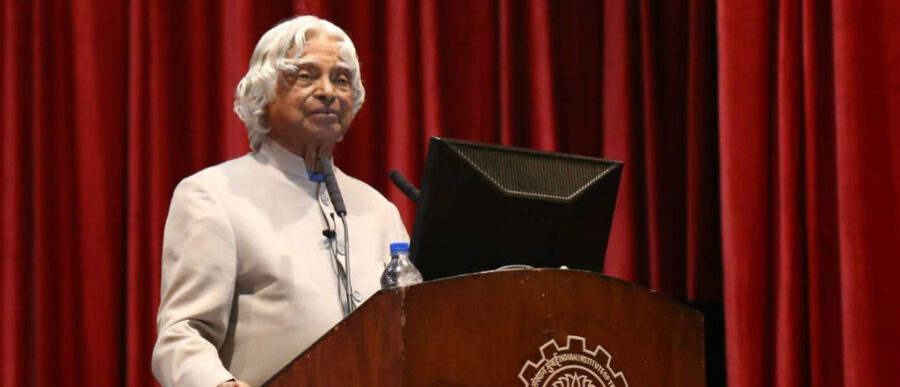
A.P.J. Abdul Kalam was a space scientist. He was a key driver of India’s space and missile programs. After he retired, Kalam tried to bridge the gap between rocket science and politics. A popular president (2002-2007), he accepted the proposal to run for a second term. He laid down one condition, however; the choice had to be unanimous. Some political parties didn’t agree. Politics (and politicians) did not win; the country lost. A popular president had to go after only one term.
In the U.S., the president has executive powers. In India, though every bill is sent to the president for his approval before its conversion into an act, he merely has a red-flag role. If parliament sends the same bill to him again, he has no recourse but to sign off on it.
Indians tend to see Kalam as a father figure, but not as one in authority. He was not just a father figure. An outsider in politics and free of political affiliations, he redefined and demystified Indian presidency. From India’s Missile Man, he became the People’s President.
“He pushed the country to reach new heights and to aspire to lead the way in its global rise, rather than aim to merely catch-up with the developed nations.” –Saikat Chaudhuri
In a 2008 interview with Knowledge at Wharton , Kalam explained his view of leadership. He emphasized that leaders should have a vision and not be afraid to go down unfamiliar paths. Most importantly, Kalam said, they should know how to manage failure (see video).
A teacher till the very end, on July 27, Kalam, 83, collapsed while delivering a lecture at the Indian Institute of Management Shillong. Below, some Wharton professors and Indian business leaders explain what they admired about the late president:
“President Kalam was an inspiration to all of us,” says Jagmohan Raju , Wharton professor of marketing and vice dean of Wharton Executive Education. “A man of science, equally adept at designing ballistic missiles and coronary stents, nuclear devices and tablet computers, writing computer code or poetry. When it came to leadership, [he] relied more on faith, humility and integrity. We all fondly recall his visit to Wharton where he charmed one and all equally with his wit and wisdom. [He was] a teacher who cared about students and young Indians all his life up to the very end. All of us who teach at Wharton, and all over the world, salute you Dr. Kalam. You will continue to inspire us all.”
Saikat Chaudhuri ,Wharton adjunct professor of management and executive director of Wharton’s Mack Institute for Innovation Management , says he is deeply saddened by Kalam’s death not only because he was a “fine human being with multiple talents,” but because “his departure is a huge loss” for India. “The country needs many more inspiring visionaries like him to realize [its] full potential on the world stage,” says Chaudhuri. “Dr. Kalam was a ‘People’s President,’ and ignited those he met with a passion not only to contribute to India’s growth, but to aim for world-class standards in their pursuits and be the best on a global platform. He was a true nationalist, who was motivated purely by a desire to contribute to a better India and world, upholding the utmost integrity. For India to reach her potential as an economic, political, and sociocultural superpower, we need many more leaders to follow in the footsteps of Dr. Kalam. He pushed the country to reach new heights and to aspire to lead the way in its global rise, rather than aim to merely catch up with the developed nations.”
“By showing that it was possible to think big and look far, he did what the best leaders always do: recalibrate what people think is possible.” –Manish Sabharwal
Jitendra V. Singh , dean and professor of business at The Hong Kong University of Science and Technology, and emeritus professor of management at Wharton recalls: “I was privileged to meet President Abdul Kalam not once, but several times…. In the time I spent with him, I was struck most of all by his simplicity, and almost childlike curiosity. He was extremely alert, and a great conversationalist. As I sat near him through the ceremony [when Kalam was awarded an honorary doctorate at the Nanyang Technological University in Singapore], I remember thinking to myself, “What a remarkable life story; what a remarkable Indian.” We have lost a remarkable Indian. While born a Muslim, he truly embraced the spirit of being Indian, quoting, as he would from time to time, from Hindu scriptures. He will be missed, but his ideas will live on, even as India takes its rightful place in the world. This is the India he dreamed about.”
Manish Sabharwal , co-founder and chairman of TeamLease Services, India’s leading staffing company, believes that Kalam did for Indian science and politics what the IT industry did for Indian business. “He raised aspirations by catalyzing a demonstration effect. By showing that it was possible to think big and look far, he did what the best leaders always do: recalibrate what people think is possible. He was also one of the first in public life to reaffirm that you don’t have to be Western to be modern, but that India must work hard to come up with our [own] definition of modernity, which must include science, technology, innovation and equality of opportunity for all.”
“ This was a President of India who commanded respect for the human being that he was, and not because of his title.” –Rajat Kumar
Allwin Agnel , founder of education network PaGaLGuY, says Kalam taught leadership to people the way it always should be done: humbly. “By humbly, leading. To touch lives by doing what is right, by never saying no to any good deed and by simply stepping up and being more. In a world of alpha leaders, he was the servant leader. A million people followed him because his words and actions always reflected his passion and willingness to help the world be a better place.”
Rajat Kumar , vice president of SnapDeal, says : “ My grandparents used to tell me stories about Dr. Rajendra Prasad (India’s first president) and Lal Bahadur Shastri (India’s second prime minister), and the faith they inspired. I was looking for that inspiration from our [current] leaders, but was not really sure whether I would ever find it — until Dr. Kalam became our president. He was a great scientist, an epitome of hard work, but most importantly, a human being who was untarnished by the trappings of power. My fondest memory of him is of a speech when he was addressing some children. When a child asked something, he sat on the steps to hear what the question was, and answered it sitting right there — on the steps of the stage with the child. This was a President of India who commanded respect for the human being that he was, and not because of his title.”
More From Knowledge at Wharton

Working for the Weekend: Downtime and Performance

Challenges for Women in the Workplace | Martine Haas

How Leadership Is Defined Differently for Women | Rebecca Schaumberg
Looking for more insights.
Sign up to stay informed about our latest article releases.
Dr. APJ Abdul Kalam Wiki, Age, Wife, Family, Death, Biography & More
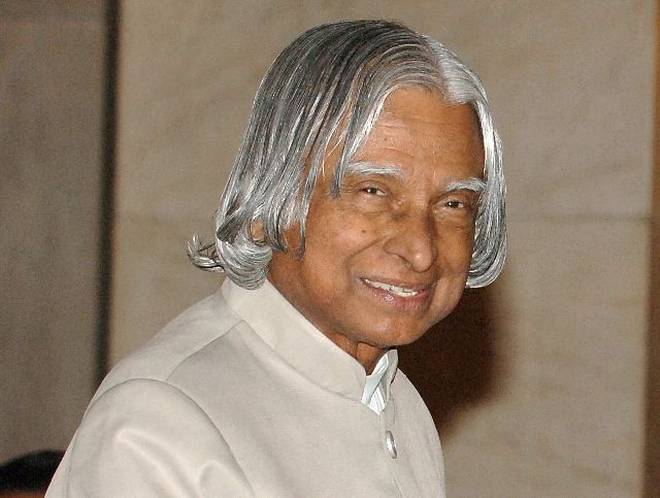
Dr. Avul Pakir Jainulabdeen Abdul Kalam is the name of Knowledge, Decency, Statesmanship, Patriotism, Glory, and Inspiration. Even if, he is no longer among us, but, his name and his deeds are and always will be motivating millions of youngsters on the planet. He still lives in the hearts of the millions of Indians. His journey from selling the Newspapers to be a President of the Nation is truly more than a miracle. Being a perfect embodiment of Science, he truly deserves to be called the ‘ Missile Man of India .’ Life with simplicity and personality with high thinking were the two major weapons of Kalam to tackle the problems of life. His name will always be taken with pride in History.
Biography/Wiki
Avul Pakir Jainulabdeen Abdul Kalam was born on 15 October 1931 in a Muslim family in Rameswaram, Madras Presidency, British India. Kalam was the youngest of his five siblings. His father, Jainulabdeen was the Imam of a mosque and owned a boat. His father took Hindu pilgrims from Dhanushkodi (Now, uninhabited) to Rameshwaram or vice-versa. His mother was a homemaker. His forefathers had a good business of trading grocery back and forth between Tamil Nadu and Sri Lanka. Moreover, they used to ferry pilgrims between mainland Tamil Nadu and Pamban Island. Therefore, the family earned the title of “ Mara Kalam Iyakkivar ” (Wooden boat-steerers). When Pamban bridge was constructed and came into operation in 1914, his family business failed and property got lost over the time. When Kalam was a child, his family was poor and Kalam used to sell the newspapers in his hometown to support his family financially.
In his early school year, Kalam was an average student but was curious to learn. He evolved his interests in Mathematics and Physics. He completed his primary and secondary education in Schwartz Higher Secondary School , Ramanathapuram, Tamil Nadu, India. For his further education, he moved to St. Joseph’s College , Tiruchirappalli, Tamil Nadu where he graduated in Physics in 1954. In 1955, he enrolled at Madras Institute of Technology to study Aerospace engineering. In Madras Institute of Technology, while working on a project, Dean was very dissatisfied with the lack of the progress of the project and threatened Kalam to revoke his scholarship. He gave Kalam a deadline of three days. Within three days, Kalam completed the project and impressed the Dean who later praised him, “I was putting you under stress and asking you to meet a difficult deadline.” Kalam narrowly missed out on achieving a dream of becoming a fighter pilot as he was placed on the ninth spot but, only eight positions were taken in the Indian Air Force.
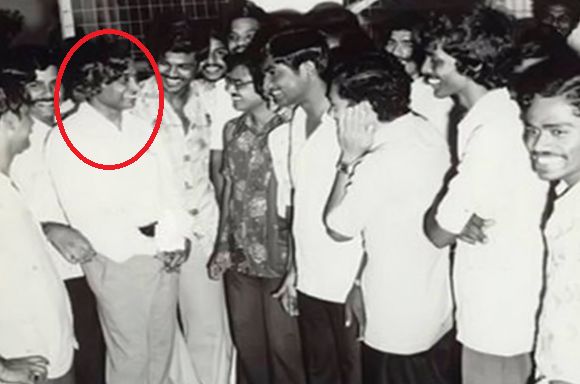
APJ Abdul Kalam during his study in Madras Institute of Technology
Kalam was born to Jainulabiddin Marakayar (Imam) and Ashiamma Jainulabiddin (Housewife). He had three brothers: Kasim Mohammed , Mohammed Muthu Meera Lebbai Maraikayar , Mustafa Kamal and one sister who was eldest, Asim Zohra .
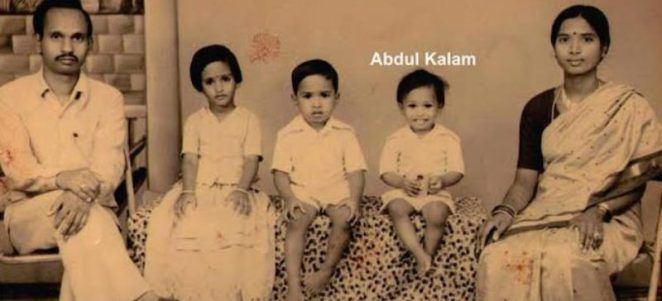
Kalam as a child with his siblings and parents
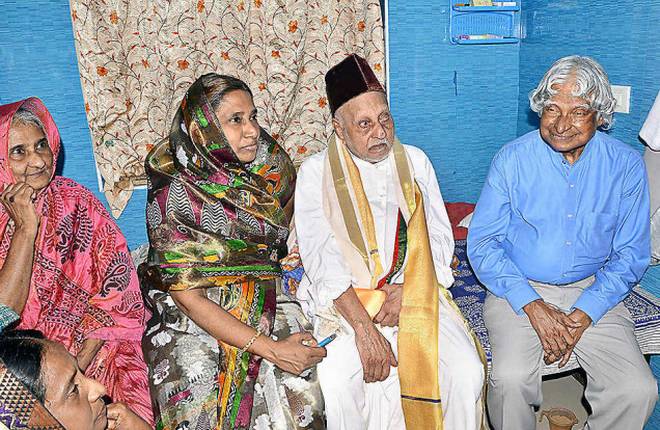
Kalam with his brother and other family members
Throughout his life, he remained unmarried.
After receiving education in Madras Institute of Technology, Kalam joined the laboratory of Defence Research and Development Organisation (DRDO) , named Aeronautical Development Establishment . Initially, he designed a small hovercraft. Kalam was also a part of Indian National Committee for Space Research (INCOSPAR) committee under the renowned Indian Space Scientist, Vikram Sarabhai .
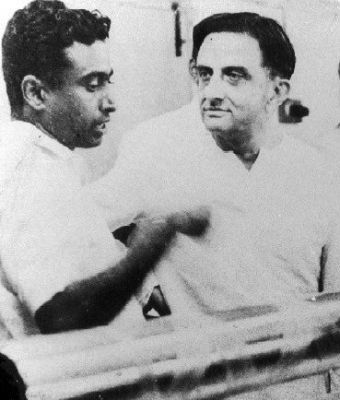
APJ Abdul Kalam (Left) with Vikram Sarabhai (Right)
In 1963 and 1964, Kalam visited NASA’s Langley Research Center in Hampton, Virginia; Goddard Space Flight Center in Greenbelt, Maryland; and Wallops Flight Facility. In 1969, he was transferred to the Indian Space Research Organisation (ISRO). He was appointed the project director of the first satellite launch vehicle of India, SLV III, which successfully deployed Rohini satellite in near-earth orbit in July 1980. From the 1970s to 1990s, Kalam strived hard to develop the Polar Satellite Launch Vehicle (PSLV) and SLV-III projects, both of which were successful. In 1974, during the first nuclear test of India, Kalam was invited Raja Ramanna . During the 1970s, two projects; Project Devil and Project Valiant were directed by Kalam to develop ballistic missiles through SLV programs. At that time, then Prime Minister Indira Gandhi allotted secret fund to these programs.
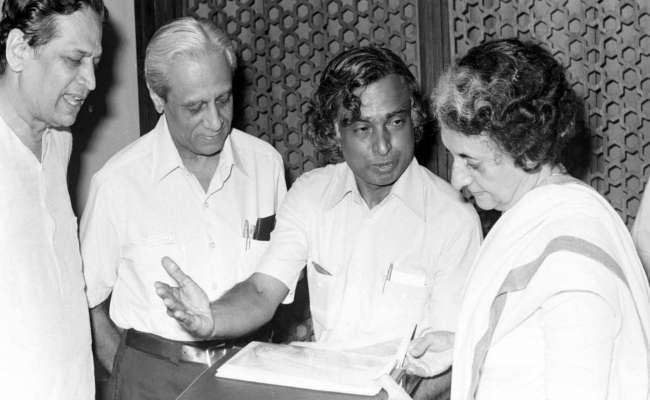
APJ Abdul Kalam with Indira Gandhi
From July 1992 to December 1999, Kalam was the chief scientific adviser to the Prime Minister and the secretary of DRDO. During the Pokhran II nuclear test in 1999, he served as the Chief Project Coordinator, along with Rajagopala Chidambaram.
During the 2002 Presidential Election, he was nominated as President of India by the National Democratic Alliance (NDA) and backed by Samajwadi Party (SP) and the Nationalist Congress Party (NCP). He received the majority of the votes bagging 89% of the votes overall defeating his rival, Lakshmi Sahgal (A revolutionary during Indian Independence Movement and a former Army officer). On 25th July 2002, Kalam became the 11th President of India.
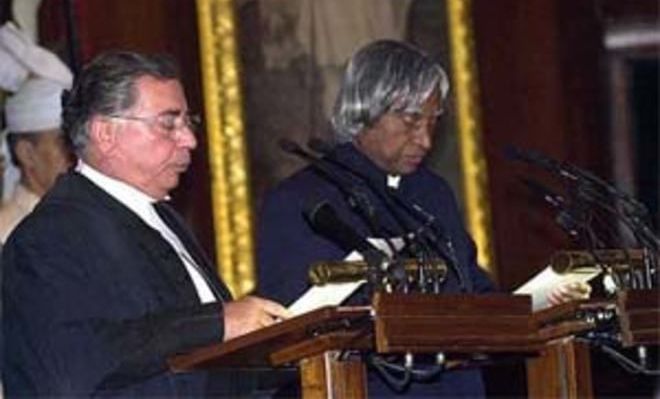
Abdul Kalam was sworn in as President by then CJI BN Kirpal
After leaving his President Office in 2007, Kalam became the visiting professor at the IIM, Shillong, IIM Ahmedabad, IIM Indore, Indian Institute of Science, Bangalore, etc.
Controversies
- During his presidential tenure, he was denounced for his inaction in deciding the fate of 20 out of the 21 mercy petitions submitted to him. During his 5 years tenure, he acted only on one mercy plea.
- In 2005, Kalam took a very controversial decision to impose president rule in Bihar.
- In 2011, he was criticised for his stand on Koodankulam Nuclear Power Plant as he supported the establishment of the nuclear plant. He was denounced for not speaking with people and even he did not assure people of their safety.
Awards/Honours/Achievements
In 1981, he was awarded, Padma Bhushan by the government of India. In 1990, he was bestowed upon Padma Vibhushan . He was honoured by the country’s highest civilian award Bharat Ratna in 1997.
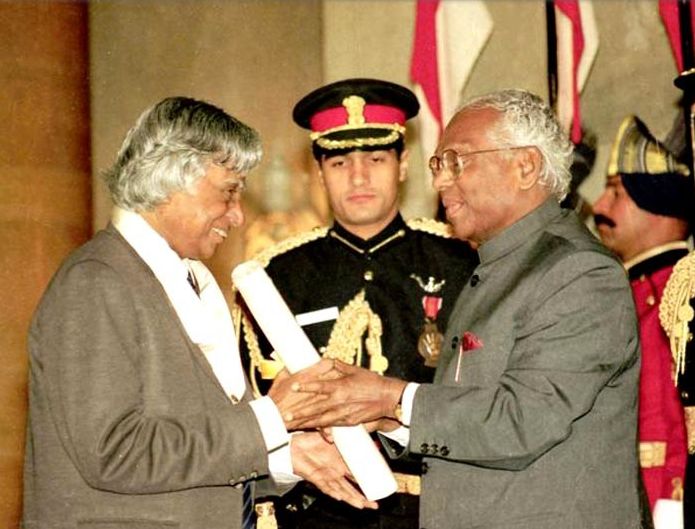
Abdul Kalam getting awarded Bharat Ratna by then President K. R. Narayanan
In 1998, he was awarded Veer Savarkar Award by Government of India. Britain’s Royal Society also awarded him the King Charles II Medal in 2007.
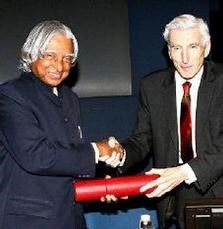
Dr. A.P.J. Abdul Kalam receiving King Charles II Medal from Lord Martin Rees, then President of the Royal Society
In 2009, he was given Hoover Medal by ASME Foundation, USA. In 2013, National Space Society, USA bestowed him upon Von Braun Award .
In his honour, the UP government changed Uttar Pradesh Technical University’s name to A.P.J. Abdul Kalam Technical University . The name of Kerala Technological University was changed to A. P. J. Abdul Kalam Technological University after his death. In September 2015, the name of Wheeler Island, a national missile test site in Odisha was changed to Abdul Kalam Island in his honour. The name of a prominent road in New Delhi was changed from Aurangzeb Road to Dr. APJ Abdul Kalam Road .
His lifestyle was very simple. He did not own many things except some: 2,500 books, a wristwatch, a Veena, a CD Player, a laptop, 6 shirts, 3 suits, 4 trousers, and a pair of shoes, his ancestral house and a small site near the house in Rameswaram, Tamil Nadu.
Death Cause
On 27 July 2015, Kalam was flying to Shillong to deliver a lecture in Indian Institute of Management in Shillong. While climbing stairs of the flight, he felt unease but got well soon after taking some hour’s rest in aeroplane. When he was delivering a lecture in the class, at 6:35 pm, he collapsed. He was rushed to a nearby Bethany Hospital. He was placed in ICU. But, at 7:45 pm, he took his last breath and died of Cardiac Arrest .
His last words to his aide, Srijan Pal Singh were: “ Funny guy! Are you doing well ?.”
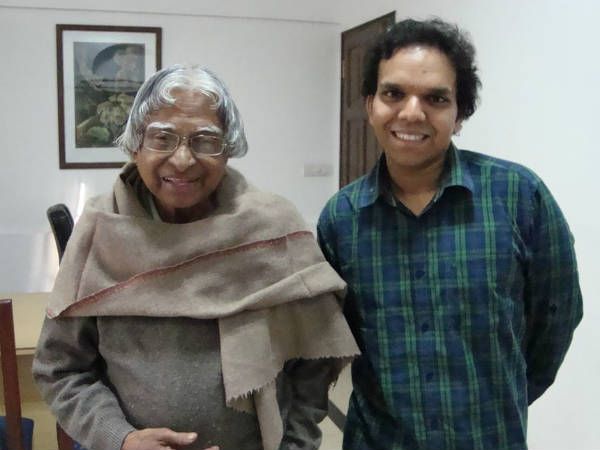
APJ Abdul Kalam with Srijan Pal Singh
On 30 July 2015, with full state honours, he was laid to rest at Rameswaram’s Pei Karumbu Ground . More than 3.5 lakh people attended the last rites including Narendra Modi (Incumbent Prime Minister of India).
Religious and Spiritual Views
He was a practicing Muslim. He used to offer Namaz daily and had fast during the month of Ramadan. However, he used to read Bhagavad Gita , a Hindu spiritual text also. He had respect for other faiths too. He often said, “For great men, religion is a way of making friends; small people make religion a fighting tool.”
He was very impressed by Pramukh Swami Ji . Kalam considered Pramukh Swami Ji as his spiritual Guru. When he met Pramukh Swami Ji for the first time on 30 June 2001, he said that he was drawn to Swami Ji’s simplicity.
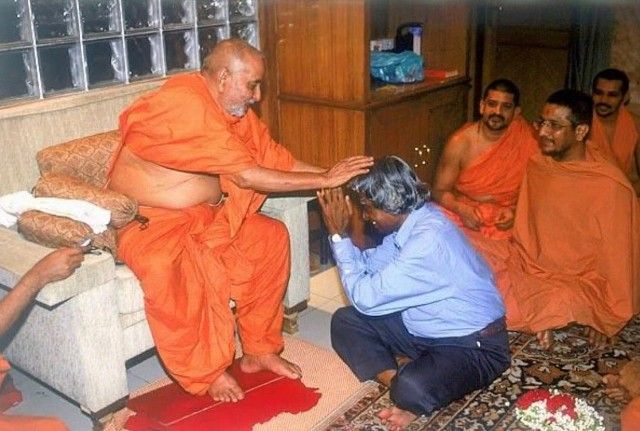
Abdul Kalam receiving the blessing from Pramukh Swami
Kalam described one incident of his meeting with Swami Ji. That incident took place just after the day of the terrorist attack on BAPS’ Akshardham, Gandhinagar complex in September 2002; he said that Swami Ji prayed for the deceased as well as terrorists and sprinkled the holy water upon the site. Kalam was inspired by Swami Ji’s calmness and compassion. Having been inspired by this incident, Kalam authored ‘ Transcendence: My Spiritual Experiences with Pramukh Swamiji. ‘
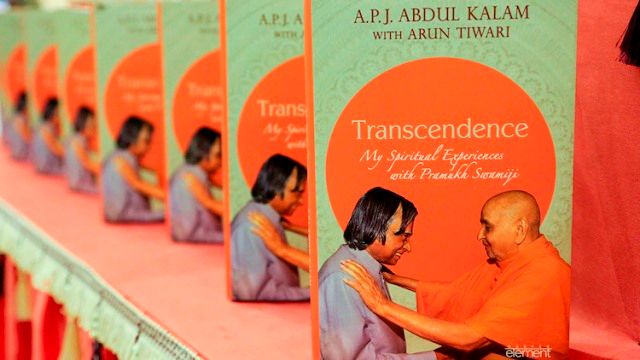
Kalam wrote Transcendence: My Spiritual Experiences with Pramukh Swamiji
Famous Books
His bibliography includes India 2020 (1998), Wings Of Fire (1999), Ignited Minds (2002), Indomitable Spirit (2006), Turning Points (2012), etc.
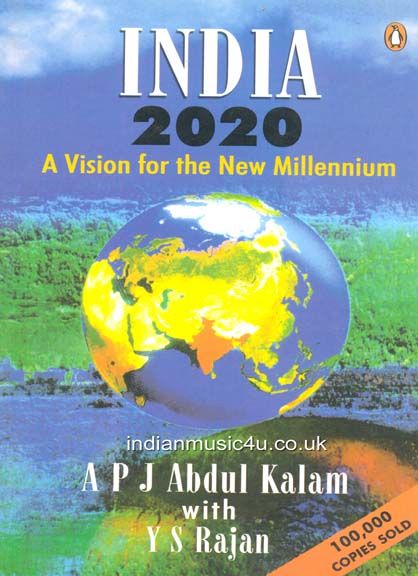
Abdul Kalam wrote India 2020
Interesting Facts
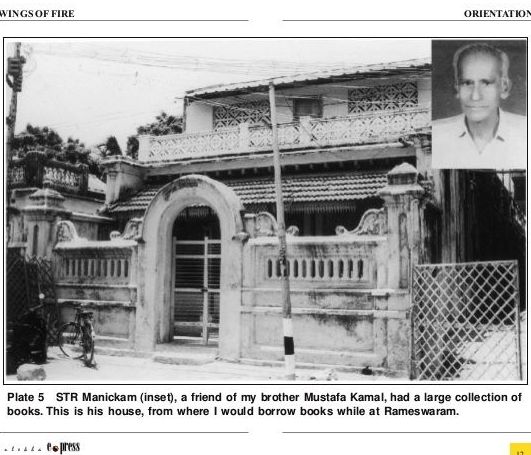
Abdul Kalam, a Book borrower
- When Kalam was only 9 or 10 years old, the Second World War started. In an interview, he revealed that he had felt the travesty of the war as it had almost reached the doors of Rameswaram.
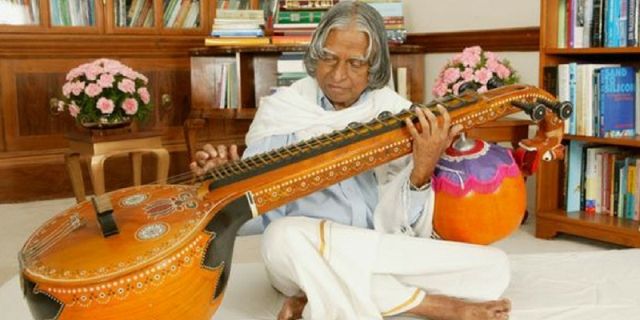
Kalam playing Veena
- When he was in DRDO, he was the chief of the Integrated Guided Missile Development Program and developed 5 missiles: Nag, Akash, Trishul, Agni, Prithvi. During this period, Pokhran-II Nuclear Tests were conducted under his guidance in which Kalam played a crucial political and technological role along with the then Prime Minister of India, Atal Bihari Vajpayee .
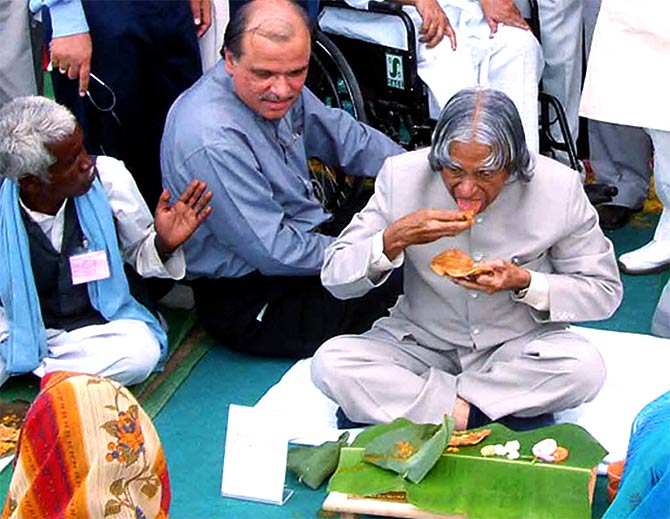
Kalam was vegetarian
- During his tenure as President of India, he used to donate his all savings to an Organisation, PURA (Providing Urban Amenities in Rural Areas).
- During his Presidential tenure from 2002 to 2007, he installed a Manipuri style hut at the Rashtrapati Bhavan referring it as a ‘thinking hut .’ He used to sit in this hut in morning and evening. The hut was demolished when his tenure ended.
- Media affectionately called him the “ People’s President ” when he was the President of India.
- Once he refused to sit on a special chair. According to him, he didn’t want to make himself superior to others.
- In November 2011, the United States apologised to Kalam for not following the appropriate procedures for expedited screening of dignitaries. When Kalam was on board to the USA in September 2011, he was frisked at the JFK airport.
- He was very positive in nature, in 2001, he boarded a helicopter from Ranchi to Bokaro district, Jharkhand. he was informed about some issues with the helicopter’s rotor, although, it was a death alarm for the crew of cockpit, he created a signature smile on everyone’s face and advised the pilot not to be petrified.
- Just after a day of his death, the government of Tamil Nadu announced that his birthday ’15 October’ would be celebrated as “ Youth Renaissance Day ” and state government further instituted “ Dr. A.P.J. Abdul Kalam Award .”
- Throughout his life, he remained unmarried, so, he is the only bachelor president of India so far.
- In 2011, in a film titled ‘ I Am Kalam ,’ he was portrayed by a poor Rajasthani boy, Chhotu who renamed himself ‘Kalam’ in the honour of his Idol.
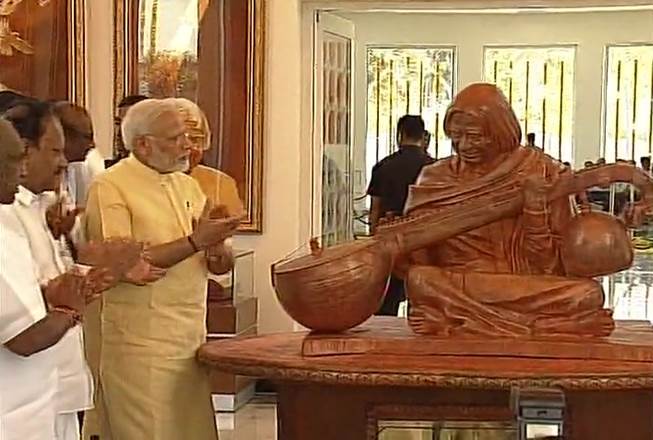
Narendra Modi inaugurating APJ Abdul Kalam Memorial in 2017
Related Posts
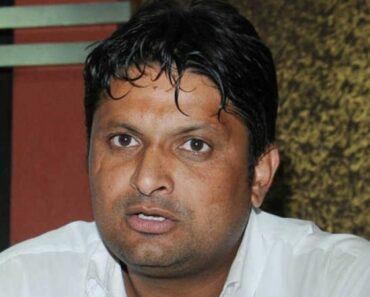
Balkar Sidhu Wiki, Age, Wife, Family, Biography & More
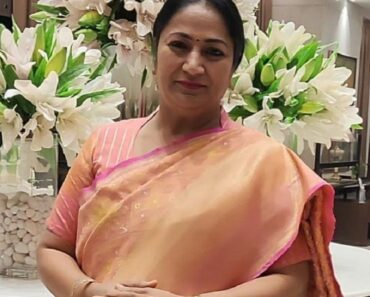
Rekha Gupta Wiki, Age, Husband, Family, Biography & More
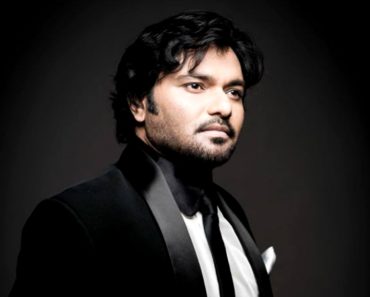

Babul Supriyo Wiki, Age, Caste, Wife, Family, Biography & More
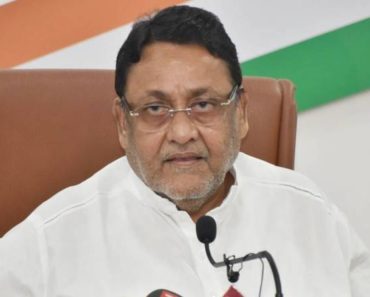
Nawab Malik Wiki, Age, Caste, Wife, Children, Family, Biography & More
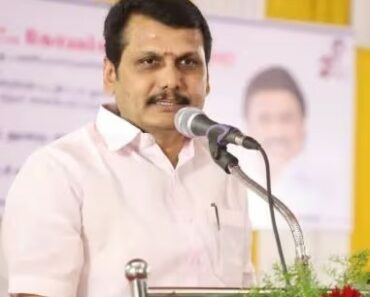
V. Senthil Balaji Wiki, Age, Caste, Wife, Children, Family, Biography & More
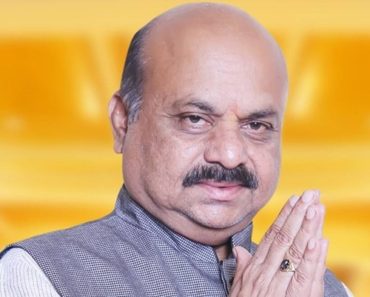
Basavaraj Bommai Wiki, Age, Caste, Wife, Children, Family, Biography & More
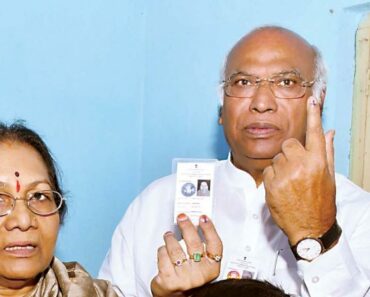
Radhabai Kharge (Mallikarjun Kharge’s Wife) Wiki, Age, Family, Biography & More
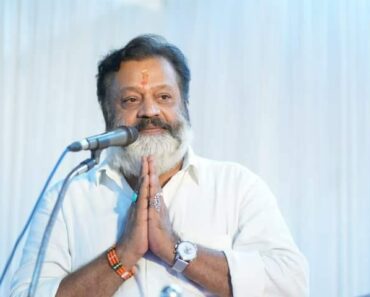
Suresh Gopi Wiki, Age, Wife, Children, Family, Biography & More

Digvijay Singh Chautala Wiki, Caste, Wife, Family, Biography & More
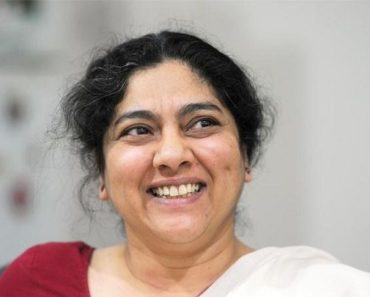
Daman Singh (Manmohan Singh’s Daughter) Wiki, Age, Family, Biography & More
One response.
great man.. salute.. thanks for sharing this article ..
Save my name, email, and website in this browser for the next time I comment.
General Studies
All Programmes
Study Material
APJ Abdul Kalam
Quest for upsc cse panels.

Sub-Categories:
GS-III: Science & Technology
Prelims : General Science
Mains : Achievements of Indians in Science & Technology; Indigenization of Technology and Developing New Technology.
Dr. Avul Pakir Jainulabdeen Abdul Kalam, commonly known as Dr. APJ Abdul Kalam, was an iconic Indian scientist, aerospace engineer, and visionary leader. Abdul Kalam served as the 11th President of India from 2002 to 2007 and is widely celebrated as the "People's President" for his immense contributions to science, technology, and the socio-economic development of India. He played a pivotal role in the development of India's ballistic missile and launch vehicle technology.
APJ Abdul Kalam - Background
Dr. APJ Abdul Kalam, born on October 15, 1931, in Rameswaram, Tamil Nadu, was an exemplary scientist, statesman, and teacher who played a pivotal role in shaping India's nuclear capabilities, missile technology, and the nation's space endeavours. Kalam breathed his last on July 27, 2015, while delivering a lecture at IIM-Shillong.
Early Life and Education
- Rameswaram roots: Dr. Kalam hailed from a modest background in Rameswaram. His father, Jainulabudeen, was a boat owner, and his mother, Ashiamma, was a housewife.
- APJ Kalam pursued a bachelor's degree in physics in 1954 fromTiruchirappalli.
- APJ Abdul Kalam received a degree in aeronautical engineering fromMadras Institute of Technology .
Dr. APJ Abdul Kalam began a distinguished career that expertly combined science, technology, and defence, leaving an imprint on history.
- DRDO: Kalam began his career as a scientist at the Aeronautical Development Establishment of the Defense Research and Development Organisation (DRDO) in 1960.
- After joining the Indian Space Research Organisation (ISRO) in 1969, Kalam oversaw the development of SLV-III , India's first satellite launch vehicle.
- Project Devil and Project Valiant aimed to create ballistic missiles using the SLV program's successful technology.
- In 1982, Kalam oversaw the development of several successful missiles, including the Agni and Prithvi missiles, earning him the title of "Missile Man of India. "
- He played a significant political and technological role during the Pokhran-II nuclear tests in 1998.
- He was the first scientist- President of India, with no political background.
Contribution of APJ Abdul Kalam
Dr. APJ Abdul Kalam's contributions spanned various domains, making him a symbol of India's scientific excellence and technological advancements.
Space Technology
- This achievement catapulted India into an exclusive club of space-exploring nations.
- PSLV: He was in charge of the evolution of ISRO 's launch vehicle programme, specifically the PSLV (Polar Satellite Launch Vehicle) configuration .
Defence and Missile Technology
- Development of ballistic missiles: Kalam oversaw the projects Devil and Valiant, which aimed to develop ballistic missiles using the technology developed for the successful SLV programme.
- IGMDP: Dr. Kalam's leadership in the Integrated Guided Missile Development Program (IGMDP) led to the development of the Agni, an intermediate-range ballistic missile and Prithvi, a surface-to-surface missile, reinforcing India's defence capabilities.
- Despite criticism, his unwavering pursuit of scientific excellence laid the groundwork for India's nuclear and space capabilities.
- It resulted in a significant reduction in the price of coronary stents , with a price reduction of more than 50% compared to when it was previously imported.
- Kalam-Raju Tablet: In 2012, Kalam and Soma Raju collaborated on the development of a rugged tablet computer for better healthcare administration in the country's rural areas. It was known as the Kalam-Raju tablet.'
- Literature: Aside from his scientific and political contributions, Kalam was an accomplished author, having written acclaimed books such as “Wings of Fire” , “My Journey”," Indomitable Spirit", “Ignited Minds” , India 2020 and many more, which continue to inspire generations.
- He worked to empower Indian youth and encourage them to take up careers in science and technology.
- Social justice: Kalam was also a champion of social justice and equality. He worked to improve the lives of marginalised and disadvantaged groups in India.
- Technology Vision 2020: As Chairman of the Technology Information, Forecasting, and Assessment Council and an eminent scientist, he led the country with the help of 500 experts to arrive at Technology Vision 2020, which provides a road map for India's transition from developing to developed status.
Awards and Honours received by Dr. Abdul Kalam
Dr. Abdul Kalam's unparalleled contributions to S&T and his dedication to advancing the nation have earned him numerous accolades and recognitions.
- Von Braun Award from the National Space Society
- Indira Gandhi Award for National Integration
- Veer Savarkar Award
- Padma Bhushan, Padma Vibhushan
- Bharat Ratna in 1997
- He received honorary doctorates from 30 universities and institutions.
- His birthday is celebrated as "Youth Renaissance Day" in Tamil Nadu
- The new bacteria was discovered on the filters of the International Space Station by researchers at NASA's Jet Propulsion Laboratory, who named it Solibacillus Kalamii in honour of Abdul Kalam.
- Wheeler Island , a national missile test site in Odisha, was renamed Abdul Kalam Island.
PYQs on APJ Abdul Kalam
Question 1: "If a country is to be corruption-free and become a nation of beautiful minds, I strongly feel that there are three key societal members who can make a difference. They are father, mother and teacher." – A.P.J. Abdul Kalam (UPSC Mains 2022)
FAQs on APJ Abdul Kalam
Who was dr. apj abdul kalam.
Dr. APJ Abdul Kalam was an accomplished scientist renowned for his contributions to science and technology, particularly in the fields of space technology and missile development. He served as the President of India from 2002 to 2007.
What was Abdul Kalam famous for?
For his contributions to the development of ballistic missile technology, he was famously known as the "Missile Man of India." Kalam served as the Prime Minister's Chief Scientific Adviser and DRDO Secretary from 1992 to 1999.
What are Dr. Kalam's notable achievements in the field of space technology?
Dr. Kalam's notable achievements in the field of space technology include the successful development of India's SLV-III and PSLV.
Why is Kalam called the Missile Man of India?
Dr. APJ Abdul Kalam, the former President of India, is known as the 'Missile Man of India' for his contribution to developing India's missile projects, the Prithvi and Agni missiles. He also played a significant role in developing the first indigenous satellite launch vehicle.
Where is Abdul Kalam Island located?
Abdul Kalam Island is located off the coast of Odisha. This island is home to the integrated missile test range. The island was originally named after the English Lieutenant Wheeler, but in September 2015, it was renamed after the former President of India, Dr. Abdul Kalam.
© 2024 Vajiram & Ravi. All rights reserved
Dr. APJ Abdul Kalam Biography, Early Life and Education, Family, Wife, Siblings, Career & More
Dr. APJ Abdul Kalam fondly known as the “Missile Man of India,” was a luminary and an inspiring figure in India’s history. A brilliant scientist and the 11th President of India, Dr. Kalam’s life serves as a testament to the power of dedication, knowledge, and integrity.
His journey from humble beginnings to becoming a renowned aerospace engineer, responsible for India’s missile development and space technology advancements, has captured the imagination of millions.
In this article, we explore the remarkable life of Dr. A.P.J. Abdul Kalam, his pivotal contributions to India’s scientific progress, and his enduring legacy as a visionary leader and an inspiration to generations worldwide.
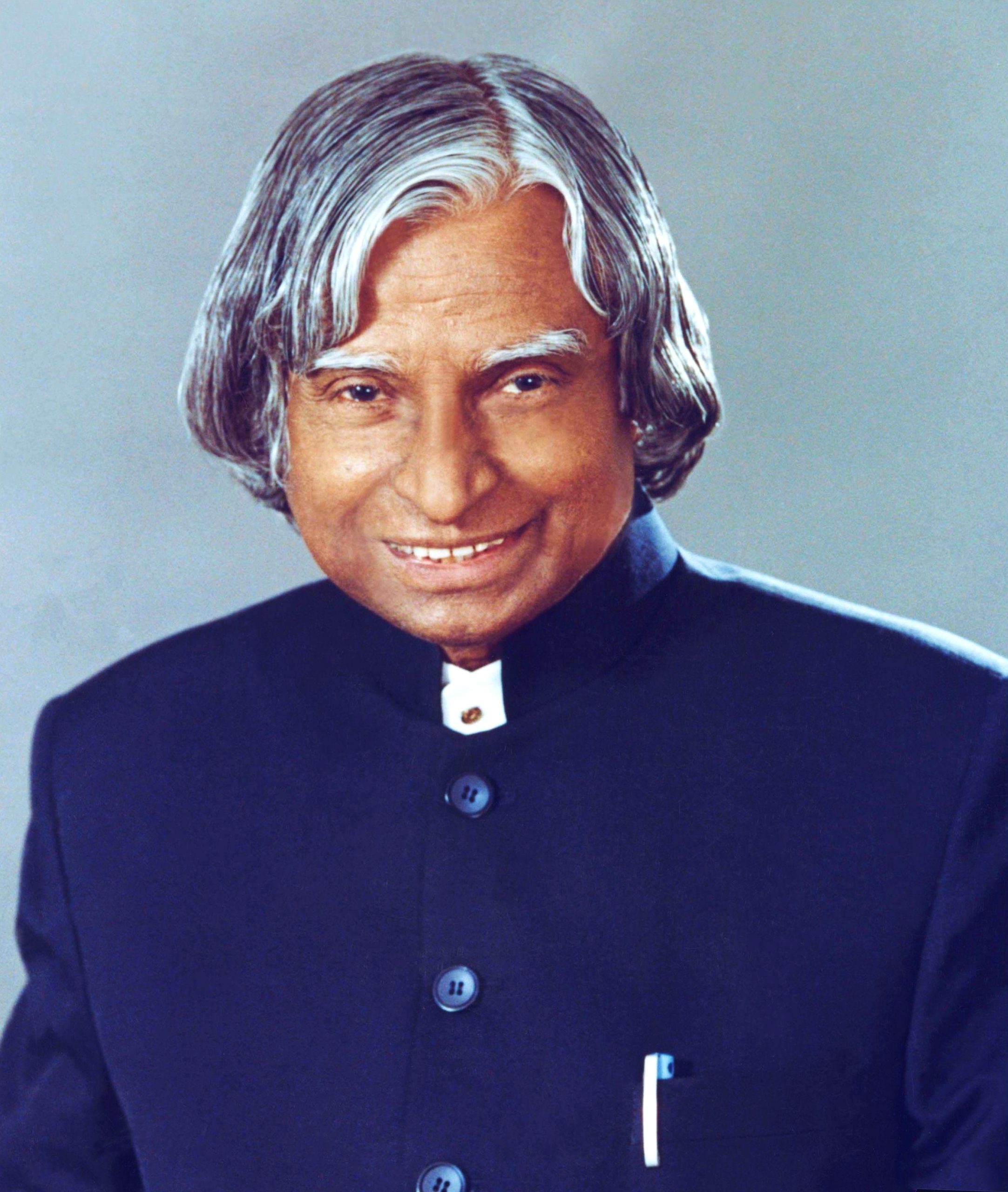
Who was APJ Abdul Kalam?
As the 11th President of India, Dr. APJ Abdul Kalam was an Indian space scientist who led the country from 2002 to 2007. Born on October 15, 1931, he grew up in Rameswaram, Tamil Nadu, and went to school to study physics and aerospace engineering. Abdul Kalam became India’s 11th President in 2002. The ruling Bharatiya Janata Party and the rival Indian National Congress party backed him.
After only one term, APJ Abdul Kalam went back to teaching, writing, and public service as a civilian. He was also known as the “People’s President.” Read APJ Abdul Kalam’s biography to learn more about his life, including his full name, achievements, ideas, quotes, and other important facts.
APJ Abdul Kalam Biography
APJ Abdul Kalam, whose full name was Dr. Avul Pakir Jainulabdeen Abdul Kalam, was a great scientist, a creative leader, and one of India’s most beloved people. He was born on October 15, 1931, in Rameswaram, Tamil Nadu. Dr. Kalam’s life story inspires people all over the world. From being poor to becoming the 11th President of India, his story shows how hard work, understanding, and a strong love for his country can pay off.
Kalam had a simple childhood but became one of India’s most loved and recognized leaders. He came from a simple home and had many problems when he was young. He was very interested in science and technology and wanted to learn everything he could.
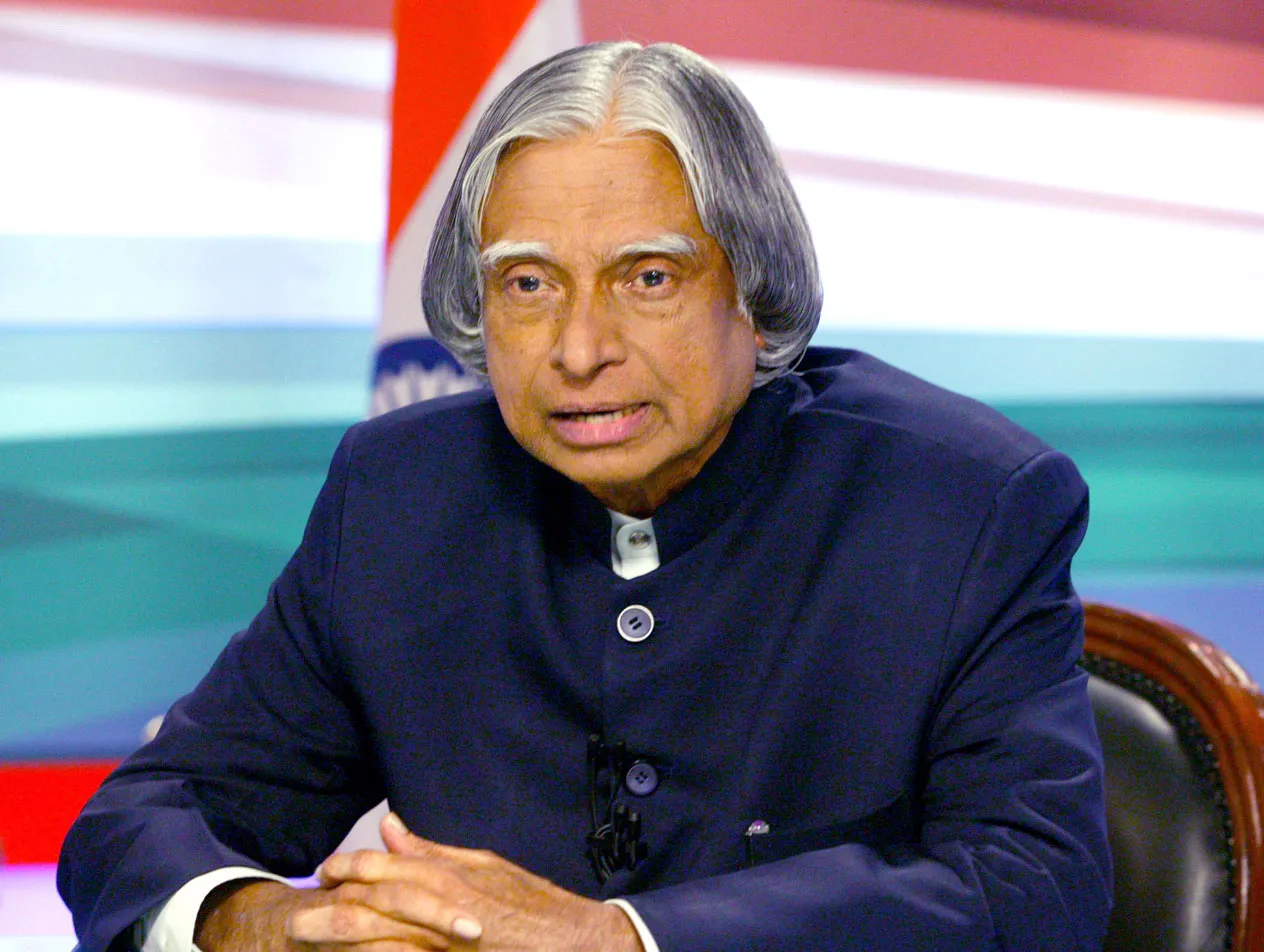
APJ Abdul Kalam Early Life and Education
In his early years, Kalam had to deal with the problems of coming from a low-income family, but his parents taught him the importance of hard work, discipline, and education. From a very young age, he was highly interested in science and technology because he had a very open mind.
The Rameswaram Elementary School was Kalam’s first school, and the Schwartz Higher Secondary School in Ramanathapuram was his next school. It was amazing how well he did in school and was interested in math and science.
In 1950, Kalam got into St. Joseph’s College, Tiruchirappalli, to study physics and get a degree. But in his second year of college, he changed his mind and chose to study aviation engineering instead, which was something he was interested in.
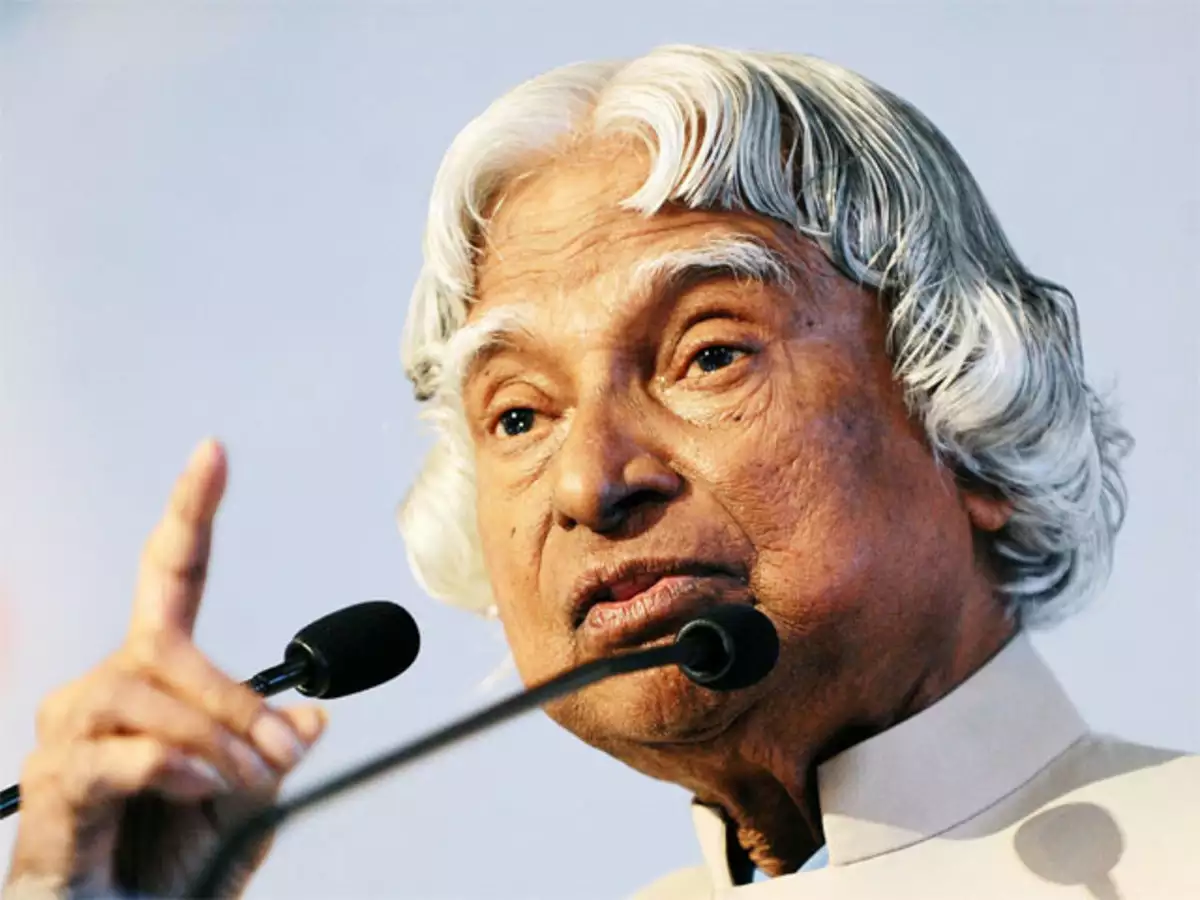
In 1954, Kalam got his degree in aviation engineering from the Madras Institute of Technology (MIT), Chennai (then called Madras). His time at MIT set him up for success as a scientist and aircraft engineer in the future.
After finishing school, Kalam worked for the Defence Research and Development Organization (DRDO) and the Indian Space Research Organization (ISRO). He was essential to India’s missile development program and significantly advanced in creating ballistic missiles.
APJ Abdul Kalam Physical Stats & More
Apj abdul kalam f amily, wife, siblings and more.
He was born into a simple Tamil Muslim family in Rameswaram, a small town in Tamil Nadu, India. His father, Jainulabdeen, owned boats, and his mother, Ashiamma, ran the household. His family was a very religious Muslim, and he grew up in a close-knit and helpful home.
The man who raised him, Jainulabdeen Marakayar, owned a boat and was the imam of a nearby mosque. His mother, Ashiamma, ran a home. His dad ran a ferry service that took Hindu travellers back and forth between Rameswaram and the now-desolate Dhanushkodi. Kalam was the youngest of five children. He had four boys and one sister. His family was wealthy and were Marakayar ranchers and traders who owned many homes and large plots of land.
In a family of five, Kalam was the youngest. He had four older brothers and one older sister. Kalam never got married and spent his whole life devoted to his work, job, and service to the country. He was careful with his money and followed strict rules, always thinking about what he owed the country and its people.
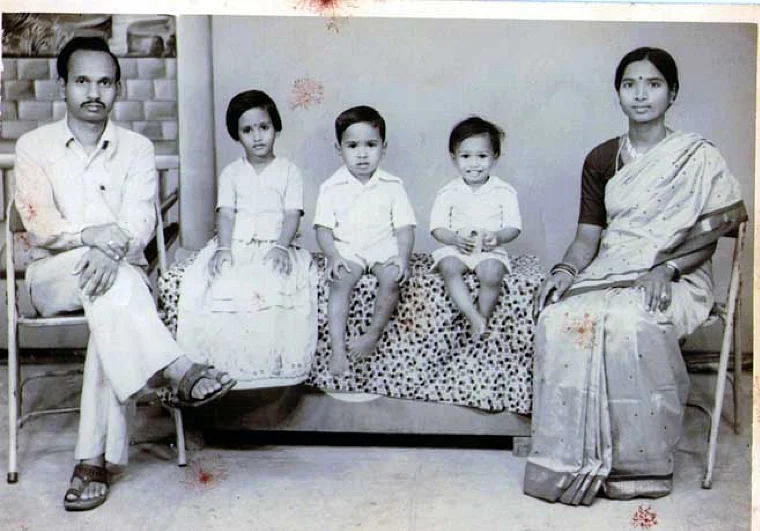
APJ Abdul Kalam Career
After attending the Madras Institute of Technology, Kalam worked at the Aeronautical Development Establishment, part of the Defence Research and Development Organization (DRDO). At first, he made a small hovercraft. Vikram Sarabhai, a famous Indian space scientist, was Kalam’s boss on the Indian National Group for Space Research (INCOSPAR) group.
Kalam went to the Langley Research Centre in Hampton, Virginia, the Goddard Space Flight Centre in Greenbelt, Maryland, and the Wallops Flight Facility in 1963 and 1964. The Indian Space Research Organization (ISRO) hired him in 1969. As project head of India’s first satellite launch vehicle, SLV III, he successfully put the Rohini satellite into orbit around the earth
in July 1980. Kalam worked hard on the Polar Satellite Launch Vehicle (PSLV) and SLV-III projects from the 1970s to the 1990s. Both of them were successful. In 1974, Raja Ramanna invited Kalam when India did its first nuclear test. In the 1970s, Kalam led two projects, Project Devil and Project Valiant, to use SLV systems to make ballistic missiles. Indira Gandhi, who was Prime Minister at the time, gave these projects secret funds.
Kalam was the Prime Minister’s top scientific adviser from July 1992 to December 1999 and the head of DRDO from December 1999 to the present. His job during the Pokhran II nuclear test in 1999 was to lead the project along with Rajagopala Chidambaram.
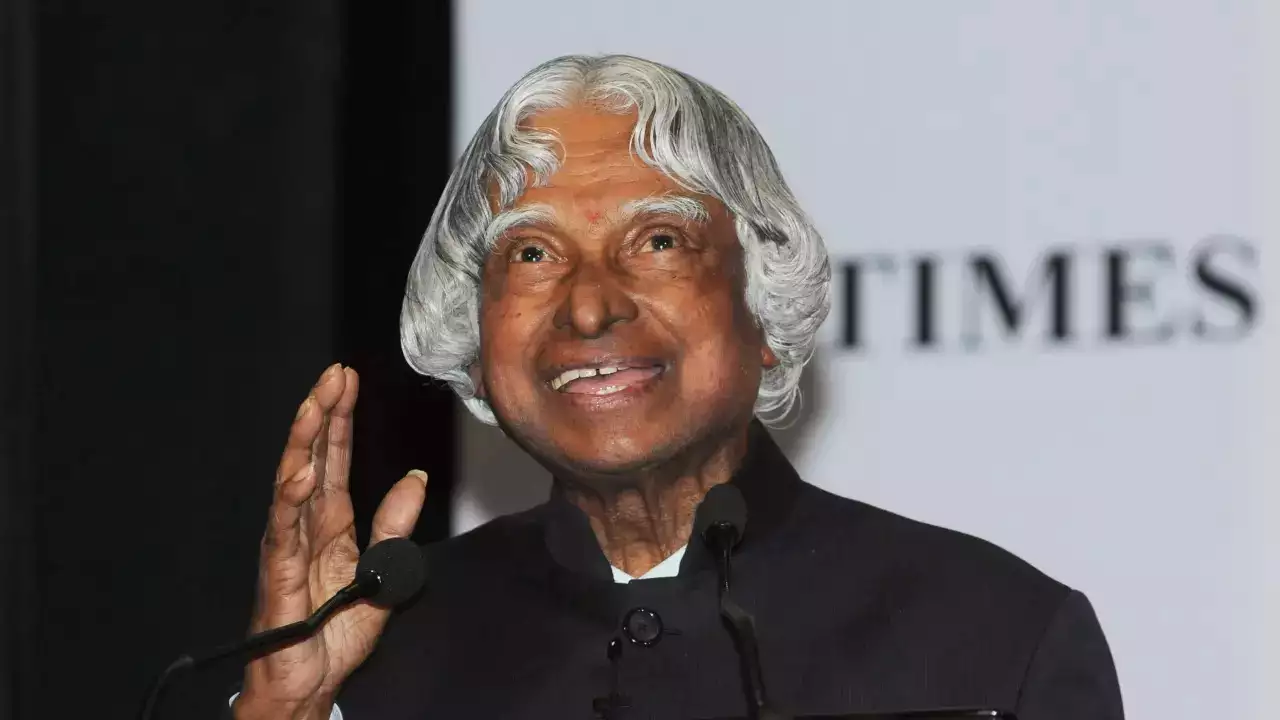
In the 2002 election for president, the National Democratic Alliance (NDA) put him forward as India’s leader, and the Samajwadi Party (SP) and the Nationalist Congress Party (NCP) backed him.
Getting 89% of the votes, he beat his opponent, Lakshmi Sahgal, a rebel during the Indian Independence Movement and a former Army officer. Kalam became the 11th President of India on July 25, 2002. When Kalam left his job as president in 2007, he became a visiting professor at the Indian Institute of Science, Bangalore, IIM Ahmedabad, IIM Indore, and other places.
- Fela Durotoye Biography
- Kathy Hochul Biography
- Matt Gaetz Biography
Awards/Honours
- 1981: Padma Bhushan by the Government of India
- 1990: Padma Vibhushan by the Government of India
- 1997: Bharat Ratna by the Government of India
- 1998: Veer Savarkar Award by the Government of India
- 2007: King Charles II Medal by Royal Society, UK
- 2009: Hoover Medal by ASME Foundation, USA
- 2013: Von Braun Award by National Space Society
- 2014: Doctor of Science by Edinburgh University, UK
APJ Abdul Kalam’s Net Worth
He lived a straightforward life. He had 2,500 books, a wristwatch, a Veena, a CD player, a laptop, six shirts, three suits, four pants, and a pair of shoes. He also owned his family home and a small plot of land next to it in Rameswaram, Tamil Nadu.
APJ Abdul Kalam Death
Kalam gave a talk at the Indian Institute of Management in Shillong on July 27, 2015. He felt uneasy while going up the flight’s stairs, but he felt better quickly after taking an hour to rest on the plane. It happened at 6:35 p.m. while he was teaching a class lesson. Someone rushed him to Bethany Hospital, which is not far away. He went to the ICU. But at 7:45 p.m., he took his last breath and died from a heart attack.
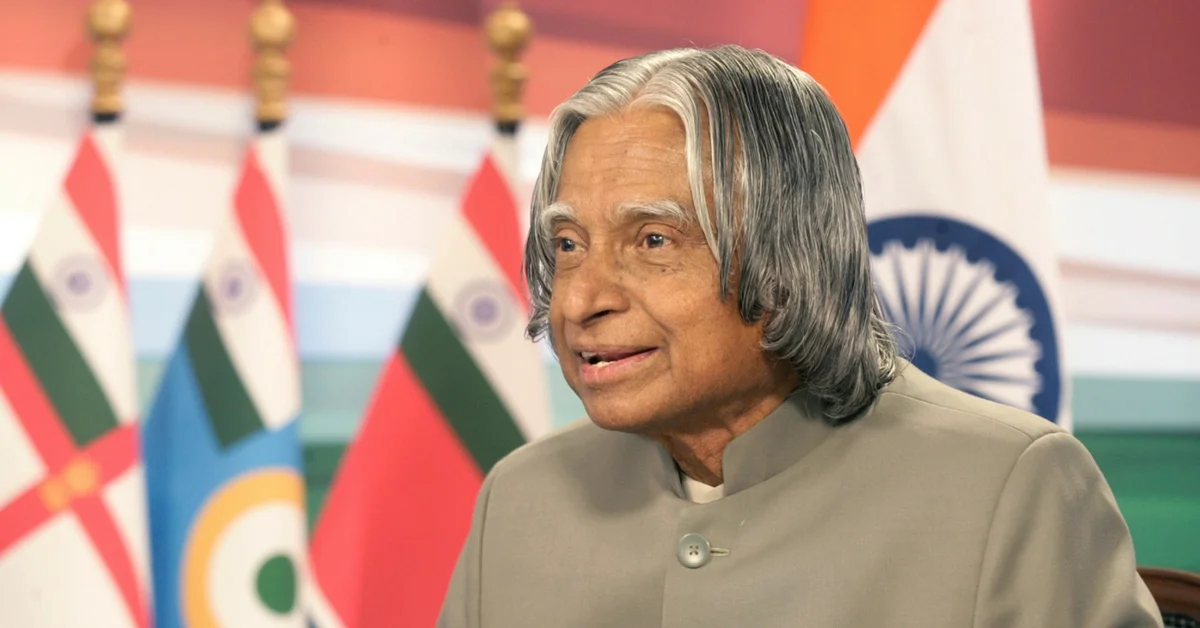
Interesting facts
- Kalam became President of India in 2002, taking over from K.R. Narayanan.
- Many people respected APJ Abdul Kalam for being humble and caring about the country’s well-being. He was the first scientist to be President.
- During his time as President, Kalam was known for supporting technology and new ideas and working to improve education, especially in rural areas.
- APJ Abdul Kalam had a lot of ambition. He thought that India could become a developed country by 2020. He wrote many books about India’s growth, such as India 2020: A Vision for the New Millennium. These books motivated a whole group of young people to work hard to make India a developed country.
- APJ Abdul Kalam was also known for being humble and easygoing. He never wanted power or money, and although he did many great things, he stayed grounded.
- People often saw Kalam taking a bike or walking to work. He was known for being easy to reach and friendly.
- In the past, APJ Abdul Kalam said, “I am not a politician; I am a normal Indian citizen.” But as President, it’s my job to encourage and motivate the people of this great country.
- Many young people in India and around the world looked up to Kalam. He thought schooling was essential and told young people to never give up on their dreams.
- Someone once told me, “You must dream before your dreams can come true.”
- Kalam also cared a lot about science and technology and thought India could become a world leader in new ideas.
- Abdul Kalam thought science and technology could help fix some of the world’s most significant issues, like disease, poverty, and food.
- It was for his work in India’s military and space program that Kalam received many awards and honours, including the Bharat Ratna, which is India’s top civilian award, in 1997.
- In 2007, the Royal Society in the UK gave APJ Abdul Kalam the King Charles II Medal. In 2008, the ASME Foundation in the USA gave him the Hoover Medal.
I am deeply convinced that you’ve been made aware of specific aspects of ‘APJ Abdul Kalam’ Biography . I beseech you to distribute this post and express your thoughts in the comments. Additionally, kindly remain in touch with our website, Biography VIP , for future updates.
20+ Quotes By APJ Abdul Kalam To Motivate You Throughout Life
Dr APJ Abdul Kalam has given a lot to India through his leadership and scientific knowledge. Here are some of his wise words that will inspire you to do great in life.

- Rajoshi Purkait
- Updated - 2024-04-01, 17:54 IST
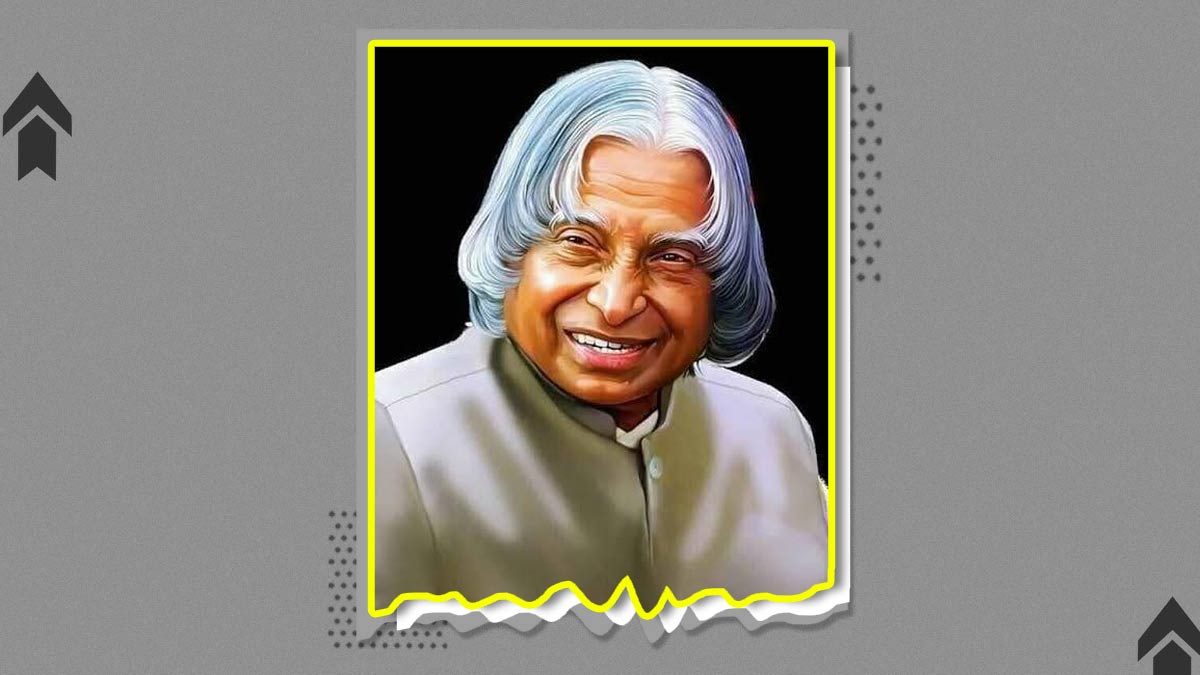
Abdul Kalam Quotes For Success
- "Climbing to the top demands strength, whether it is to the top of Mount Everest or to the top of your career."
- "Don't take rest after your first victory because if you fail in second, more lips are waiting to say that your first victory was just luck."
- “Dream is not that which you see while sleeping it is something that does not let you sleep.”
- "I firmly believe that unless one has tasted the bitter pill of failure, one cannot aspire enough for success."

APJ Abdul Kalam Quotes On Knowledge
- “The best brains of the nation may be found on the last benches of the classroom.”
- “The purpose of education is to make good human beings with skill and expertise... Enlightened human beings can be created by teachers.”
- “Creativity is seeing the same thing but thinking differently.”
- "All of us do not have equal talent. But, all of us have an equal opportunity to develop our talents."

APJ Abdul Kalam Motivational Quotes
- “If you fail, never give up because F.A.I.L. means 'First Attempt In Learning'. End is not the end, in fact E.N.D. means 'Effort Never Dies'. If you get No as an answer, remember N.O. means 'Next Opportunity'. So Let's be positive. "
- "Small aim is a crime; have great aim."
- “Confidence and hard-work is the only medicine to kill a disease called failure!”
- “You should always remember that we don't just build on successes, we also build on failures.”

Positive Thinking Abdul Kalam Quotes
- "Look at the sky. We are not alone. The whole universe is friendly to us and conspires only to give the best to those who dream and work."
- "If you want to shine like a sun, first burn like a sun."
- "All birds find shelter during a rain. But eagle avoids rain by flying above the clouds."
- "All wars signify the failure of conflict resolution mechanisms, and they need post-war rebuilding of faith, trust and confidence."
Your skin and body like you are unique. While we have taken all measures to ensure that the information provided in this article and on our social media channels is credible and expert verified, we recommend you consult a doctor or your dermatologist before trying a home remedy, quick hack or exercise regime. For any feedback or complaint, reach out to us at [email protected]

IMAGES
VIDEO
COMMENTS
A.P.J. Abdul Kalam (born October 15, 1931, Rameswaram, India—died July 27, 2015, Shillong) Indian scientist and politician who played a leading role in the development of India's missile and nuclear weapons programs. He was president of India from 2002 to 2007.. Kalam earned a degree in aeronautical engineering from the Madras Institute of Technology and in 1958 joined the Defence Research ...
Avul Pakir Jainulabdeen Abdul Kalam BR (/ ˈ ɑː b d əl k ə ˈ l ɑː m / ⓘ; 15 October 1931 - 27 July 2015) was an Indian aerospace scientist and statesman who served as the 11th president of India from 2002 to 2007. He was born and raised in Rameswaram, Tamil Nadu and studied physics and aerospace engineering.He spent the next four decades as a scientist and science administrator ...
Avul Pakir Jainulabdeen Abdul Kalam, better known as APJ Abdul Kalam, was an illustrious scientist turned statesman who served as the 11 th President of India from 2002 to 2007. Kalam spent more than forty years as a science administrator and scientist mainly at the Indian Space Research Organization (ISRO) and Defence Research and the ...
A.P.J. Abdul Kalam was an Indian scientist and politician who served his country as president from 2002 to 2007. By Biography.com Editors Published: Nov 28, 2023 Hindustan Times // Getty Images
A.P.J. Abdul Kalam was a prominent Indian scientist who served as the 11th President of India from 2002 to 2007. Renowned for his pivotal role in the nation's civilian space programme and military missile development, he was known as the Missile Man of India.
APJ Abdul Kalam's early life was steeped in humble beginnings and shaped by values instilled in him by his parents. Born into a modest Tamil Muslim family on October 15, 1931, in Rameswaram, a small town in Tamil Nadu, India, Kalam was the youngest of five siblings. Jainulabdeen, his father, owned a boat and was a local mosque's imam.
A P J Abdul Kalam's Biography - About His Family and Struggle Life. Dr. A P J Abdul Kalam was born to a poor Tamil Muslim family. He lived with his family in the temple city of Tamilnadu, Rameswaram, where his father, Jainulabdeen, had a boat and was an imam of a local mosque. At the same time, his mother, Ashiamma, was a housewife.
Avul Pakir Jainulabdeen Abdul Kalam BR was an Indian aerospace scientist and statesman who served as the 11th president of India from 2002 to 2007. He was born and raised in Rameswaram, Tamil Nadu and studied physics and aerospace engineering. He spent the next four decades as a scientist and science administrator, mainly at the Defence Research and Development Organisation (DRDO) and Indian ...
View history; General What links here; Related changes; Upload file; Special pages; Permanent link; Page information; Cite this page; Get shortened URL; ... கலாம்; pronunciation (help · info); 15 October 1931 - 27 July 2015) usually known as A.P.J. Abdul Kalam, was a famous Indian aerospace engineer. He was the 11th President of ...
APJ Abdul Kalam Biography: Dr. APJ Abdul Kalam was an Indian aerospace scientist who served as the 11th President of India from 2002 to 2007. He was born on October 15, 1931, raised in Rameswaram ...
Dr. APJ Abdul Kalam was the eleventh President of India, serving from 2002 to 2007. He was born on May 15, 1931, in Rameswaram, Tamil Nadu, and studied physics as well as aeronautical engineering.
A.P.J. Abdul Kalam was a space scientist. He was a key driver of India's space and missile programs. After he retired, Kalam tried to bridge the gap between rocket science and politics. A ...
Dr. A.P.J. Abdul Kalam (15 Oct, 1931 - 27 July, 2015): India's 11th President, Dr. A.P.J. Abdul Kalam has been often referred to as the 'Missile Man of India' and was the Project Director of India ...
Biography/Wiki. Avul Pakir Jainulabdeen Abdul Kalam was born on 15 October 1931 in a Muslim family in Rameswaram, Madras Presidency, British India. Kalam was the youngest of his five siblings. His father, Jainulabdeen was the Imam of a mosque and owned a boat. His father took Hindu pilgrims from Dhanushkodi (Now, uninhabited) to Rameshwaram or ...
Dr. APJ Abdul Kalam, born on October 15, 1931, in Rameswaram, Tamil Nadu, was an exemplary scientist, statesman, and teacher who played a pivotal role in shaping India's nuclear capabilities, missile technology, and the nation's space endeavours. Kalam breathed his last on July 27, 2015, while delivering a lecture at IIM-Shillong.
As the 11th President of India, Dr. APJ Abdul Kalam was an Indian space scientist who led the country from 2002 to 2007. Born on October 15, 1931, he grew up in Rameswaram, Tamil Nadu, and went to school to study physics and aerospace engineering. Abdul Kalam became India's 11th President in 2002. The ruling Bharatiya Janata Party and the ...
Domestic affairs Gujarat tour. In 2002, soon after assuming office, the President announced his decision to visit the state of Gujarat, which had been struck by an earthquake as well as deadly riots. In his book Turning Points, Kalam wrote that he undertook the visit despite Prime Minister Atal Bihari Vajpayee's objections.. Return of bill. In 2006, Kalam became the first President to return a ...
Dr. A.P.J. Abdul Kalam, former President of India was born on 15th October 1931 in Rameshwaram. He was a scientist, writer and recipient of many awards & honours. Know more APJ Abdul Kalam and his achievements in this article. Get other relevant events on the same date in history for IAS Exam. For UPSC 2023, follow BYJU'S.
About the bookDr. Kalam was a learner all his life. He commanded subjects beyond his realm of work. He felt home with Science as well as social subjects. He did not allow anything to escape his notice and he wanted to know everything. As he toured different parts of the country and world, he made bid to learn and whenever he had a doubt, he would consult books and people to resolve it.
Watch The Most Powerful and Most Detailed Video On Dr APJ Abdul Kalam.APJ (Avul Pakir Jainulabdeen) Abdul Kalam was 11th President of India from 2002 to 2007...
The Dr. A. P. J. Abdul Kalam Award, named after the 11th President of India and aerospace scientist A. P. J. Abdul Kalam, is awarded by the Government of Tamil Nadu in recognition of contributions on scientific development, humanities and students' welfare.. Dr. A.P.J. Abdul Kalam Award Announcement. On 31 July 2015, Then Chief Minister of Tamil Nadu J. Jayalalithaa announced after the death ...
Positive Thinking Abdul Kalam Quotes. Check out these quotes on positivity by Dr APJ Abdul Kalam. "Look at the sky. We are not alone. The whole universe is friendly to us and conspires only to give the best to those who dream and work." "If you want to shine like a sun, first burn like a sun." "All birds find shelter during a rain.
Major Works of A.P.J. Abdul Kalam: "Wings of Fire" (1999): An autobiography that provides insights into Abdul Kalam's life journey, from his early days in Rameswaram to his significant contributions to India's aerospace and defense programs. The book also explores his thoughts on leadership, education, and the future of India.
Dr. A. P. J. Abdul Kalam Science City is a science city that is currently under construction. It is being built by Department of Science and Technology Government of Bihar to promote and popularize Science among people. It is located at Rajendra Nagar, Patna in the Indian state of Bihar.It aims to promote and popularize science as well as demonstrating and preserving the history of scientific ...
APJ Abdul Kalam Biography//Untold Story Of Abdul Kalamhindi storybiography#lovestory hindi story abdul kalamstory creator
History. KTU was established by the Government of Kerala through an Ordinance on 21 May 2014. Kuncheria P. Isaac, a former Member Secretary of the All India Council for Technical Education was appointed as the first Vice-Chancellor of the university on 1 September 2014, and M. Abdul Rahman, former All India Council for Technical Education Director, was appointed as the first Pro-Vice-Chancellor.
Dr. APJ Abdul Kalam University Institute of Technology. Dr. APJ Abdul Kalam UIT Jhabua, popularly known as UIT Jhabua, is a public (government) college in Jhabua. Madhya Pradesh, India. The institution was established by the government of Madhya Pradesh with the name UIT Jhabua. It is a constituent institution of Rajiv Gandhi Prodoyogiki ...